Bismarck Hunt (May 1941)
The battleship commanded by the captain 1 of the rank of Ernst Lindemann (Ernst Lindemann) and on which the headquarters of Admiral Lyutyens was located, left Danzig on the night from 18 to May 19. The crew of the battleship was informed about the objectives of the operation only at sea. Near the Arkona Peninsula, a meeting with the destroyers Friedrich Eckold and Z-23 arrived from Swinemünde, and the heavy cruiser Prinz Eugen (captain of the 1 rank Brinkman) approached from Kiel. For wiring through the Big Belt, a Sperrbrecher 13 minefield breaker joined them.
Around the 15 of the 20 in May, after passing the Great Belt, the compound unexpectedly met the Swedish cruiser Gotland. Its commander, captain 2 of the rank Agren, immediately reported this fact to Stockholm.
An English naval attaché in Stockholm, Commander Denham, had a regular meeting that day with his Norwegian counterpart, who among others News told him this one too. Returning to the embassy, Denham with the note “very urgent” handed the encryption to the Admiralty. By 3.30 the next day, the operational intelligence center informed navy and coastal command.
All of these events marked the beginning of a large-scale hunt of the British fleet for the German “pocket battleship” in May 1941.
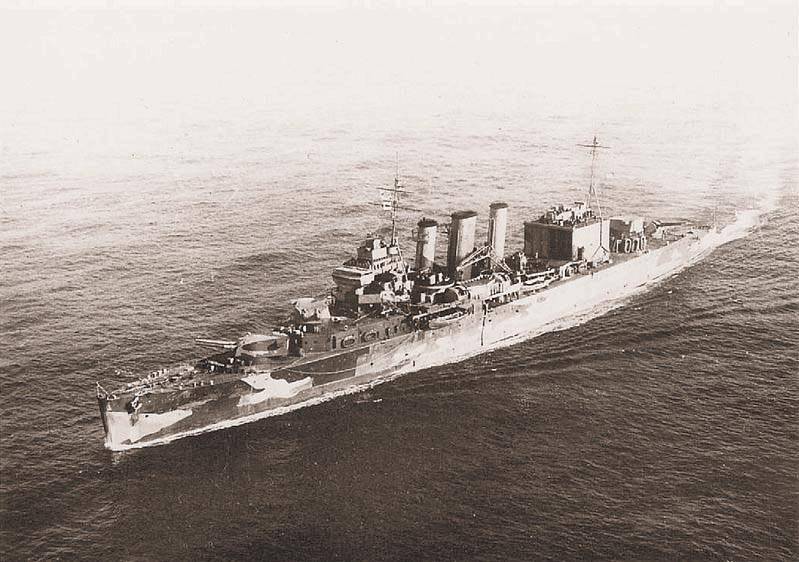
Received early in the morning on 21 in May a message about the release of the battleship (LC) “Bismarck” and the heavy cruiser (CRT) “Prinz Eugen” from Kattegat, and the patrols of the Danish Strait KRT “Norfolk” and “Suffolk” from Scapa Flow left the line cruiser (LCR ) Hood, LC “Prince of Wales” and 6 destroyers (EM): “Electra”, “Anthony”, “Echo”, “Icarus”, “Achates” and “Antelope”.
Ha “Norfolk”, commanded by 1 rank captain Alfred Phillips (Alfred JLPhillips), was held by the flag commander of the 1-th cruiser squadron Rear Admiral William F. Wake-Walker. Captain 1 of the rank of Robert M. Ellis stood on the command bridge of the MCT Suffolk.
The compound heading for the Danish Strait from the main base of the Metropolitan fleet was commanded by Vice Admiral Lancelot E.Holland, who was holding a flag on the LCR Hood. The ship itself, the pride of the British fleet, was commanded by Captain 1 of rank Ralph Kerr (Ralf Kerr).
CRL Manchester (captain Herbert A. Parker) and Birmingham (captain Alexander CGMadden) were ordered to guard the strait between Iceland and the Faroe Islands.
AB “Victorious” (captain Henry C.Bovell) was in Scapa Flow, who, accompanied by the LCR 'Repulse' (captain William G.Tennant), was supposed to go 22 on May with the WS8B escort to the Middle East. The exit of both ships had to be canceled, they came at the disposal of Admiral Sir John Tovy, who headed the operation to capture the German LK, Commander-in-Chief of the Metropolitan Fleet.
From the moment the operation began, the right to go on the air was strictly limited - virtually all British ships observed radio silence.
The search has begun
After receiving a German connection discovery message aviation coastal command in the Korea Fjord (on May 21 at 13.15 a reconnaissance plane flying over Bergen photographed the ships at anchorage - decoding of the image showed that these were “Bismarck” and “Prinz Eugen”), Admiral J. Tovi sent “Hood”, “Prince of Wales ”and 6 EMs in the Icelandic Hwal fiord. Under the guise of an airstrike * on Bergen, the British took a few more pictures, confirming their assumptions that the ships were ready to enter the Atlantic.
* - Even in secret reports, the British wrote that "the bombing attempt on the Norwegian coast, undertaken" at random "on May 21, was a fiasco - because of the dense fog enveloping the coast, only two aircraft reached the fjords, but they also did not find the enemy."
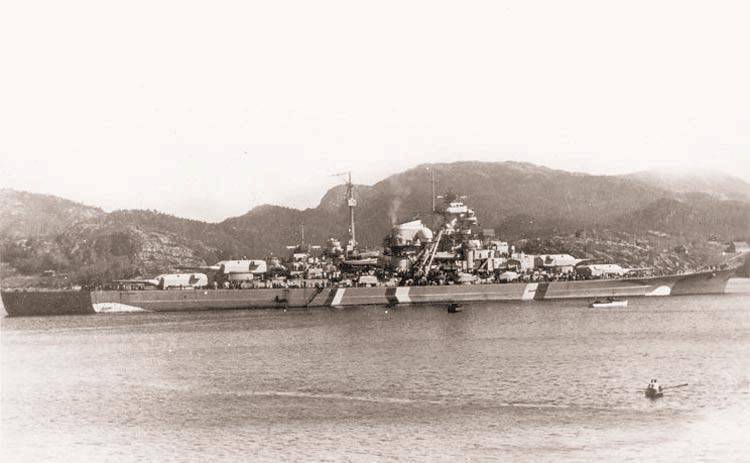
In 19.00, Admiral G. Lyutyens, confident of the British opening the operation, interrupting the brewing of the КРТ, ordered to leave the fjord. This happened on 19.45 21 May.
On the following day, the weather worsened: the clouds over the North Sea descended to an altitude of 600 m, in the Danish Strait it was pouring rain, visibility did not exceed half a mile.
In such conditions, aerial reconnaissance seemed useless, but the commander of the Northeast station of Hatston, located on the Orkney Islands, captain 2 of the rank Fancourt (HLSt.J.Fancourt) nevertheless sent one aircraft through the North Sea. Pilot Lt. N. Goddard (NNGoddard) and the observer, Commander G. Roterdam (GARotherdam) reached Bergen, under a heavy anti-aircraft fire aerial photography and returned safely to Hatston. German ships in the fjords were not found - information about this was reported to Admiral J. Tovi in 20.00 on May 22.
In the meantime, the German ships, following the 24 hub, moved around Trondheim around 7.00 on May 22. Earlier, around 4.00, Admiral G. Lutyens released escort EMs to Trondheim, and the compound headed for Fr. Jan Mayen, where the meeting with the tanker “Weissenburg” was planned. K 21.00 German ships reached 68 ° N.
Having asked the command about the presence of British forces in Scapa Flow and received an answer (based on the data of air reconnaissance, the Germans believed that there were 4 LC, 1 AB, 6 KR and 17 EM), in 23.20, Admiral G. Lutyens refused to bunker and turned on W, intending to enter the Atlantic by the Danish Strait.
Admiral J. Tovi, without having accurate data on the whereabouts of the Bismarck and Prinz Eugen, proceeded from the assumption that German ships were sent to the Atlantic to destroy merchant ships. After specifying the orders to his forces - sending the Arelusa CRL (A.-C.Chapman) to the aid of Manchester and Birmingham and ordering to organize continuous air patrols in dangerous areas - in 22.45 22 in May, the Metropolitan Fleet Commander left Scapa Flow accompanied by the AB "Victorious", the 2 th cruiser squadron and five EM. * He intended to take a central position. The flag of Admiral J. Tovi was waving in the falchs of the King George V LC, commanded by Captain 1 of the rank Wilfrid Patterson (Willfrid L. Patterson).
* - Rear Commander Admiral E. Curtis (ATCurteis), commander of the 2 cruiser squadron, raised his flag on the Galatea CRL, commanded by rank 2 captain Edward Sim (Edward WBSim). The rest of the Kyrgyz Republic were commanded by 2 rank captains William GAgnew - “Aurora”, Michael Danny (Michael M. Denny) - “Kenya”, and Rory C. O'Conor - “Neptune”. The squadron also included Hermione, commanded by Jeoffrey N.Oliver.
Destroyers: flagship Inglefleld - Captain 2 Rank Percy Todd (Percy Todd), Commander 3 Fleet EM, "Intrepid" - Captain 3 Rank Roderick Gordon (Roderick C.Gordon), "Nestor" - Captain 3 Rank Conrad Cond. Hankey (Conrad B.Alers-Hankey), “Punjabi” - Captain 3 Rank Stuart Bas (Stuart A.Buss) and “Active” - Lieutenant Commander Michael W. Tomkinson.
In the morning they were joined by the LCR "Repulse". The entire day of 23 in May was followed by a connection to W. Aerial reconnaissance was not conducted due to bad weather.
Opponent detected
The weather in the Danish Strait was unusual: the air was clear over pack ice, stretching for 80 miles from the coastline, and about 10 miles from the ice edge, the rest of the water space and Iceland were shrouded in dense fog. In 19.22, a radar 18-node motion “Suffolk”, with its radar, detected 20 ° bearing at the 7 mildew for large surface targets. "Bismarck" and "Prinz Eugen", enveloping the edge of the pack ice, were located in the NUMX mile of NW from North Cape.
Immediately radiating about the detection of the target, the captain of the 2 rank R. Elles turned to SO, so as not to be detected himself. 20.30 also installed a Norfolk radar contact. *
* - Although the first one to find the enemy was “Suffolk”, the message from “Norfolk” in the Admiralty was received earlier - in 21.03 it was transferred to the commander of the Fleet metropolis. Hood received the first message from Suffolk, on 20.04.
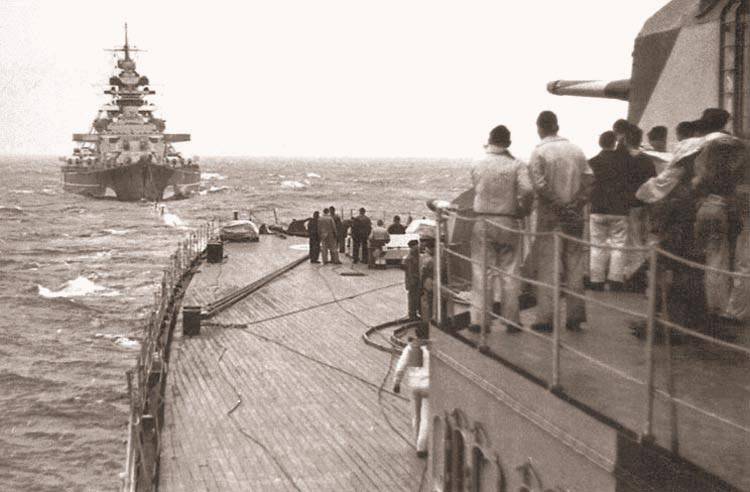
Also having a radar "Bismarck" discovered and classified "Suffolk" in 18.20 by ship time (on German ships, the time on 1 was ahead of English) at a distance of 7 miles. Having prepared the data for firing the main caliber and informing your commander about the detection of the English CU, after 10 min. LK was ready to open fire when his radar fixed another target at a distance of 6 miles — soon “Norfolk” appeared at full speed for an instant from the darkness behind the stern LC, but then retreated.
The Bismarck detection radiogram went on the air on 20.32.
"Bismarck" managed to make 5 volleys, but did not hit the Englishman, but only brought down his own radar. By ordering Prinz Eugen to take a seat ahead, Lyutens increased the speed to 30 nodes and changed course, trying to break away from the British CR. It succeeded - around midnight the contact was lost; Norfolk and Suffolk, confident that the Germans had turned back, headed for the strait, but soon returned to the same course.
As soon as the first message from “Norfolk” was reported to Admiral J. Tovi, he turned on W and lay down on the 280 ° course, increasing the squadron course and intending to intercept the enemy next morning near Iceland.
Vice Admiral L. Holland received the first message from “Suffolk” in 20.04, being in 300 miles of the enemy. He ordered the captain of the 1 rank R. Kerr to lie down on the course 295 ° and increase the course to 27 nodes. Having passed a new course about 50 min. and observing the efforts of the six EMs to keep up with the flagship on a very fresh wave (the wind reached 5 points), Holland allowed them to slow down and follow “optimally”. However, EM all night long maintained the maximum possible course.
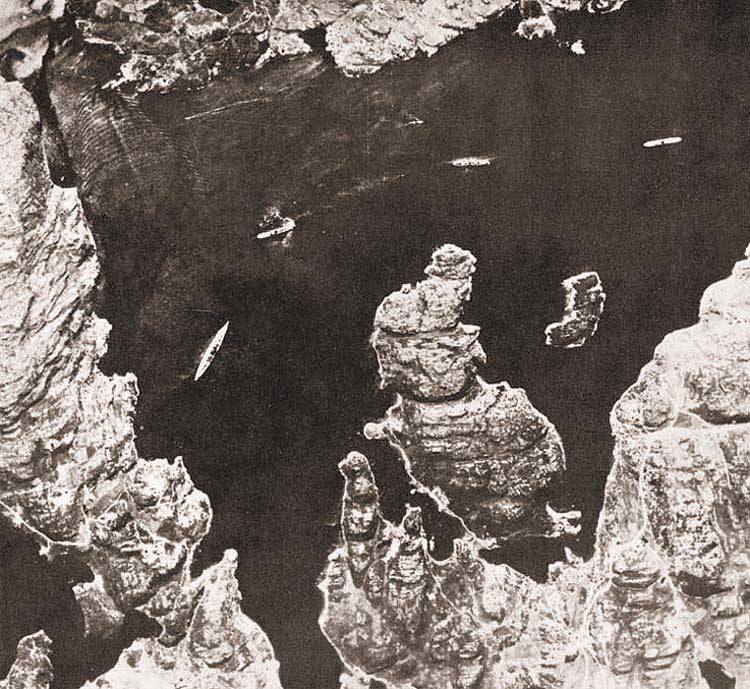
In 23.18, they received an order to line up in “Order No. XXUMX”, i.e. take a position ahead of the LC and LCR. At midnight, a report arrived that enemy ships were located approximately 4 miles following the course of 120 °.
Soon, the British ships reduced the speed to 25 nodes, and on 0.17 they set course on N.
It was expected that the enemy would be at the opening range of fire near 1.40, so by 0.15 all the preparations for the battle were over, and the ships raised battle flags. Just at this time, the KR lost the radar contact with the target.
Vice Admiral L. Holland was clearly nervous. In 00.31, he ordered the transfer to "Prince of Wales": if the enemy is not detected before 2.10, he will lie on the opposite course and follow them until contact is restored; LK and LCR will pursue “Bismarck”, a “Prinz Eugen” he leaves for “Norfolk” and “Suffolk”. For stories it remained unknown whether this order was transmitted and whether the CR received it ...
At Prince of Wales, the Walrus reconnaissance aircraft was prepared for take-off, but at 1.40, due to the deterioration of visibility, the bailout had to be canceled, the fuel was leaked out of the tanks and secured in a traveling manner. After 7 min. the flagship raised the flag signal: if in 2.05 the LKR is turned on the course of 200 °, EM to continue the watch course on N. Visibility was such that there was no confidence in receiving an order from all EMs from the flagship. At 2.03, "Hood" lay down on a course of 200 °.
Since the meeting with the enemy before dawn was unlikely, the team was allowed to rest.
* * *
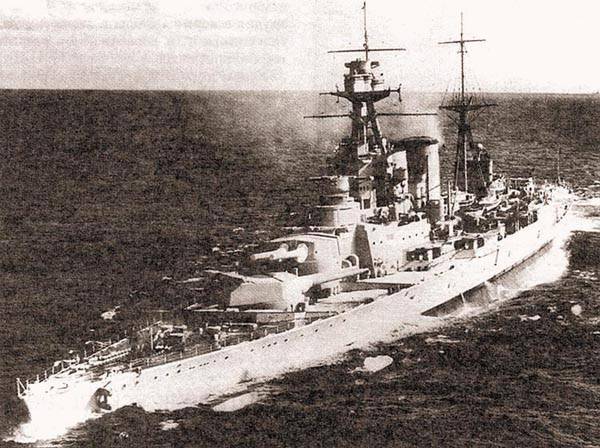
The Admiralty at that time was most concerned about the security of the convoys. In the North Atlantic, there were at least 11 (6 went to the metropolis, 5 followed in the opposite direction). The WS8B convoy was considered the most important: 5 transports with British infantry en route to the Middle East in escorting KPT Exeter, CRL Cairo and eight EMs.
Since the LCR "Repulse", which was supposed to follow as part of the cover, was at the disposal of the commander-in-chief, an order to go to sea to protect the caravan of transports with troops that had already completed more than half of the way along the coast of Ireland, or to take part in the battle with the German ships, in 0.50 24 May was received by Force Ad commander, Vice Admiral Sir James Somerville.
To 2.00, all his ships left Gibraltar.
* * *
All night long with 23 on 24 in May, Norfolk and Suffolk were pursued by the German LC, which supported the 27-28 nodes.
"Hanging on the tail," from time to time the British MCT still lost visual contact with the enemy in the shade of rain or in a snow charge. Then on the "Suffolk" radar was included.
In 2.47, when the radiomeristers "Suffolk" again saw the marks of the targets on the screen of their radar and the radiogram of this reached Vice-Admiral L. Holland, "Hood" increased the course to 28 nodes.
In 4.00, the distance between the main opponents was approximately 20 miles. In 4.30, visibility improved to 12 miles, in 10 min. followed by an order to prepare for the departure of a seaplane "Walrus" on the "Prince of Wales". Execution of the order was delayed. * “Hood” was the maximum possible 28-node move on the SO course 240 °. In 4.50, the more seaworthy "Prince of Wales" came forward, and "Hood" took the position in his left stern shell, bearing 230 °.
* - Aviabenzin was flooded, and it cost the car life - they did not have time to lift it into the air before the battle began, and then, damaged by fragments of shells and representing a danger to the ship, it had to be dropped overboard.
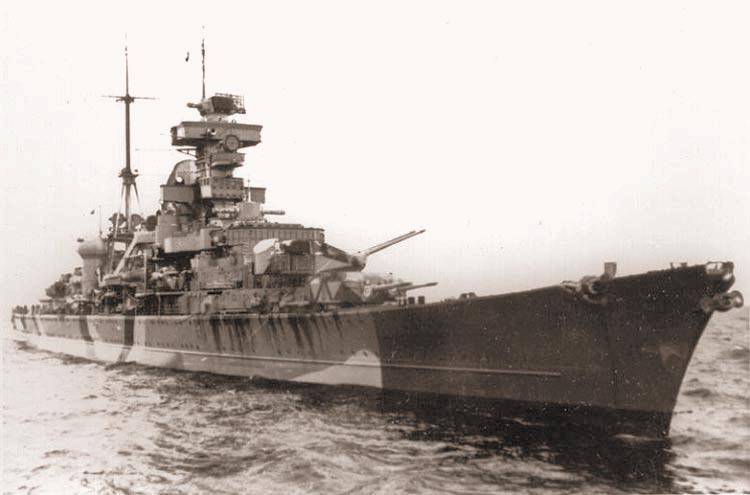
A quarter of an hour later, “Hood” again assumed the functions of a flagship.
Meanwhile, the Norfolk and Suffolk signalmen, in anticipation of the moment when the Arctic twilight turned into a day, were looking at the horizon in the south. If this had happened in 3.25, “Bismarck” would have been detected visually at a distance of 12 miles. At that moment, LK began turning to the right, and when Suffolk also turned to keep its distance, a sudden strong gust of wind caught the plane that was on the catapult and put it out of order.
In 4.45, the Norfolk radio operators intercepted a radiogram from the Icarus EM, in which he gave his place and Achetes place - the ones who accompanied Hood EM were on the CRT stern. This was the first message from which Rear Admiral W. Wake-Walker could find out that the line forces were nearby.
In 5.16, Norfolk signalmen found smoke on the left aft, soon Prince of Wales and Hood appeared on the horizon.
The first combat contact. Doom "Hood"
On both ships back in 5.10 24 May1941, when the dawn began, the highest level of combat readiness was established.
The British found the enemy first, making contact on 5.35 ° in 335 ° at a distance of 17 miles. Two minutes later, the “Hood” and the “Prince of Wales” simultaneously, over the blue pennant raised on the flags of the flagship, shifted left aboard the 40 ° in order to turn out to be right-handed to the enemy.
In 5.41, “Hood” had a target in 80 ° bearing, but in 5.49, on the next signal, the ships went to the 300 ° course.
At the same time, the flagship raised the signal "GSB 337 L1", which meant "to fire on the German ship, which is on the left of 3379 bearing". The left-handed (left-hand ship) turned out to be “Prinz Eugen”, and an instant before the opening of fire on the “Prince of Wales” halyards, the “GOB 1” signal went up - “Move the target one to the right”, i.e. shoot at "Bismarck".
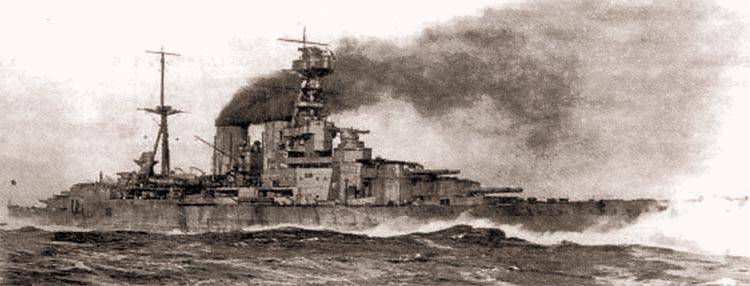
The "Prinz Eugen" radar detected a target from the left side near 5.00, but in 5.45, when the smoke of the British ships was seen by the signalmen, the artillery officer of the German ship mistakenly identified them as КРТ. There was an order to charge 203-mm guns with high-explosive shells, usually used by the Germans for zeroing.
At dawn, in 5.52, when the distance was reduced to 25000 yards (22750 m), Hood opened fire on Bismarck, he immediately replied.
The Bismarck fire was controlled by the senior artillery officer of the frigate-captain Paul Asher. He already had combat experience - in the same position, Asher commanded the gunners of the Admiral Graf Spee during the battle of La Plata.
The Bismarck achieved cover from the 2 of the volley — a fire broke out on Hood in the area of the stern 102-mm left-side cannon, a fire quickly engulfed the entire central part of the ship. The flame had a pink hue; thick smoke came out of the fire.
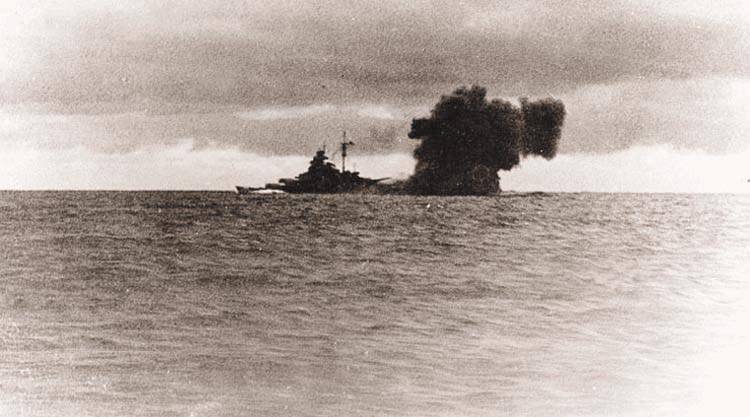
“Prince of Wales”, commander of which 1 rank captain John Leach (John S. Leach) ordered his artillery officer to independently control the shooting, opened fire a moment later, but only achieved a cover with a 6 salvo (1 went down with a flight ).
In 5.55, the flagship “Hood” and “Prince of Wales” were turned on the 2 rumba to the left on the blue pennant, which opened the corners of the shelling of the nose tower of the main caliber to the last. LK produced 9 th volley. Five minutes later, two blue pennants appeared on the “Hood” falls — he intended to tighten the rumba with another 2.
At that moment, “Bismarck” just made the 5 th volley - “Hood” was split into two with a powerful explosion that stood between the feeding tube and the mainmast. The nasal part, turning over, immediately began to sink, and the stern, shrouded in smoke, kept afloat.
After all, 8 min. after the start of the battle, the LCR, which had been the pride of the Royal Navy for many years, disappeared between the waves, and only a cloud of smoke brought down by the wind reminded us of a handsome ship.
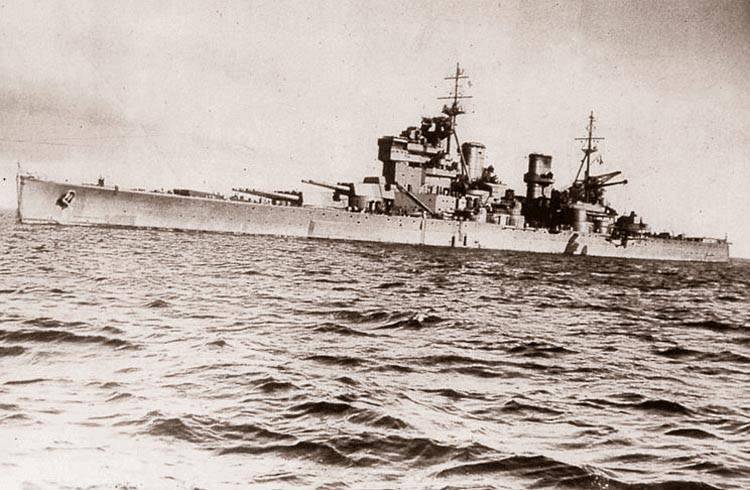
“Prince of Wales” changed course to the right in order not to collide with the remnants of “Hood”, and passed near the place of his death: 63 ° 20′N, 31 ° 50′W.
The distance was reduced to 18 thousand yards, (16380 m), and Bismarck did not fail to take advantage of this, introducing its universal artillery into action.
Having received 4 380-mm shells from the main German caliber LK, captain 2 of rank J. Leach, who miraculously survived the explosion of one of the three smaller-caliber shells, destroyed the bridge in 6.02 aft, the ship took a significant amount of water to the damaged compartments.
In 6.13, the British LC, covered with a smoke screen, turned on the course 160 °. The aft tower of the main caliber continued to fire, but during its turn it stuck (it was only possible to put the tower into operation by 8.25). The distance to the German LC was 14500 yards (13200 m). "Prince of Wales" managed to produce 18 volleys with a main caliber and five - universal.
Bismarck, who did not attempt to pursue the Prince of Wales or continue the fight, also received hits. *
* - According to a survey of the surviving members of his team, the German LK was hit three times by British shells: one of them hit the starboard at the bow, making an underwater hole (water flooded three compartments); 2 - fodder, in the main armor belt, shifting the plate (flooded one compartment); 3 th stitched the deck without exploding and only destroying the motorboat. Some of the respondents claimed that the hits were from the 3 of the “Hood” salvo, others believed that the 2's hit in the “Bismarck” was the work of “Prince of Wales”.
The British assess the situation
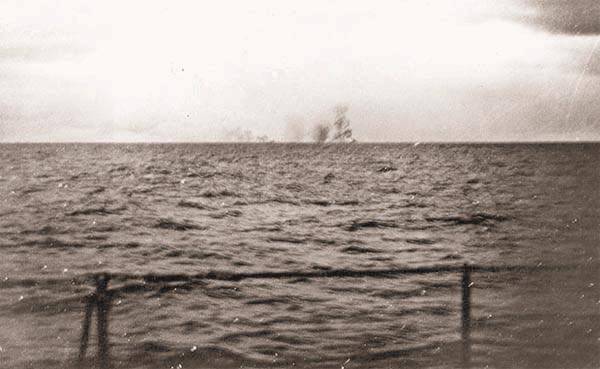
After the death of Vice-Admiral L. Holland, the command was to move on to the next-rank flagship, Rear Admiral W. Wake-Walker, who held the flag on the Norfolk KPT, which at that moment was 15 miles to N and went to the battlefield 28-nodal move.
Suffolk and Norfolk, naturally, could not stay away from the battle, but they were too far away. In 6.19, “Suffolk” launched 6 volleys with its main caliber, however, as it turned out later, due to an erroneous target designation, the shells did not reach the target.
In 6.30, “Norfolk” got close to “Prince of Wales”, Rear Admiral U.Wake-Walker told LC about taking command and allowed him to follow such a move, which allowed him to maintain the state of the ship. Captain 1 Rank Leach responded that he could give 27 nodes. The flagship then ordered an EM from the guard of the deceased “Hood” to begin searching for people.
* - “Anthony” and “Antelope” as early as 14.00 on 23 May were released by Vice Admiral Holland to Iceland for refueling. In 21.00, after receiving information about the detection of the enemy, they again went to sea. Together with “Hood” remained “Echo”, “Electra”, “Icarus” and “Achates”. When the battle began, they were approximately xNUMX miles to N and to NW.
In 6.37 EM, an order was received from the commander of the 1 th cruiser squadron to search for surviving sailors from the sunk LKR and in 7.45 they approached the site of the death of “Hood”. Various wooden fragments, balsa life rafts, and cork mattresses floated in a large oil spill. Electra discovered and boarded three sailors on board.
From Iceland, Malcolm approached the site of the death of the “Hood”, continuing the ineffective search all day. On 9.00, “Echo” gave a radio message that he, along with “Icarus”, “Achates”, “Antelope” and “Anthony”, is heading to the Hvalfiord. There the EM arrived at 20.00.
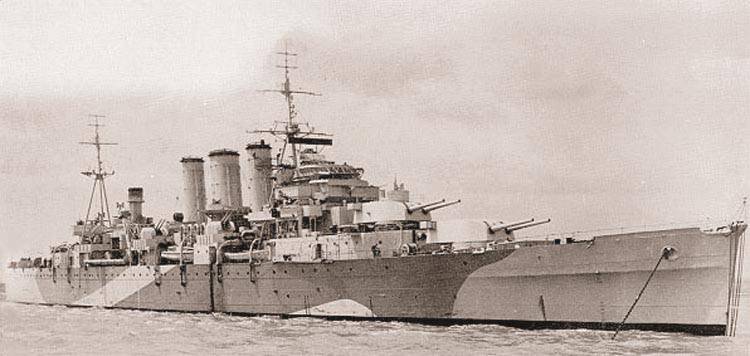
In 7.57, “Norfolk” reported that “Bismarck” had shortened the course and it may be damaged. Soon, the assumption was confirmed: the flying boat “Sunderland” in 8.10, which departed from the Icelandic airfield, discovered the German LK and announced that it leaves behind an oil plume.
Admiral J. Tovi and King George V were in 360 miles. Rear Admiral U.Wake-Walker had to make a decision: either to continue the battle in cash, or, continuing tracking, to wait for reinforcements.
The condition of the LC was decisive: it took more than 400 tons of water to the damaged feed compartments, two main-caliber guns could not fight (two guns in the feed tower were able to be commissioned to 7.20), the ship could not progress more than 27 nodes.
In addition, LK entered service quite recently - Captain Leach reported on the readiness of the ship to join the battle not later than a week before the described events. The towers of the main caliber LC were a new model, they, of course, had “growing pains” - the last salvos during the morning battle lay down with undershoot and with a large spread across the rear sight.
So Rear Admiral W. Wake-Walker decided to wait. Throughout the day, “Prince of Wales” and “Norfolk” continued the chase without engaging in battle.
After 11.00, visibility deteriorated, visual contact was lost at noon in the shade of a fine rain.
The adversary slips away
Even at night (at 1.20), in order to prevent any possibility of the unnoticed return of the German ships, the KRL Manchester, Birmingham and Arethusa, patrolling between Iceland and the Faroe Islands, were sent to the northeastern tip of Iceland.
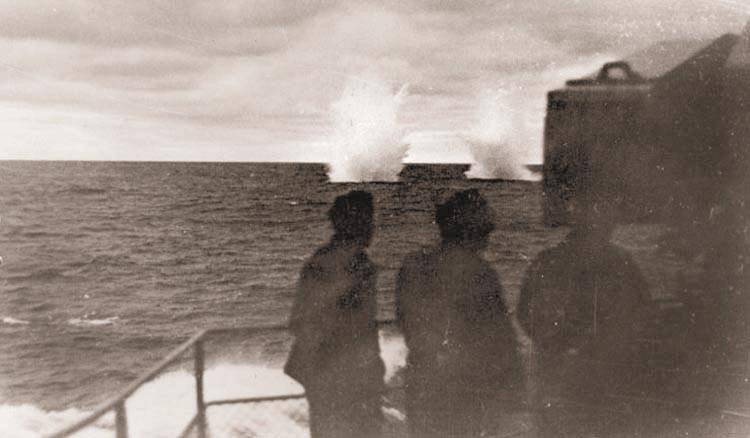
The Admiralty sent the Rodney LC, which was located about SO XN in the 550, along with four EMs, escorting the military transport “Britannic” to the concentration area.
In 10.22, the commander of “Rodney” captain 1 of the rank Frederick Dolrympl-Hamilton (Frederick HG Dalrymple-Hamilton) received an order to leave one EM in the guard of transport, and follow the other three on W.
Leaving the “Eskimo” EM (lieutenant JVWilkinson) with “Britannic”, “Rodney” along with “Somali” (captain Clifford Caslon), “Tartar” (commander Lionel P. Skipwith) and “Mashona” (commander William H.Selby) full move on to the aid of the forces of prosecution.
In the Atlantic were two more English LC - "Ramilles" and "Revenge".
The first followed in the cover of the NH127 convoy coming from Halifax and was located in the XXUMX S from Bismarck.
In 11.44, the commander of the Ramillies LC, 1 rank captain Arthur D. Read, was given a decoded order from the Admiralty: leave the convoy and go to N to cut off the Bismarck from the west. In 12.12, the order was executed. The commander of the "Revenge" captain 1 of the rank of E. Archer (ERArcher) executed the order to immediately withdraw from Halifax and also to move closer to the enemy.
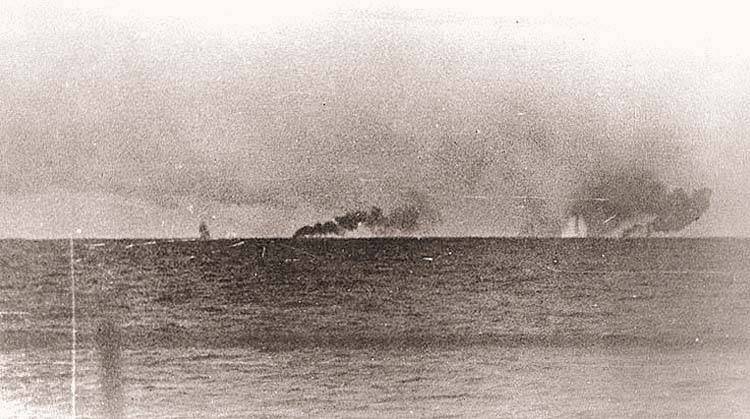
The commander of the 18 cruising division, he is the commander of the Edlinbourgh KRL, Commodore Charles M. Blackman, who patrolled between 44 and 46 degrees N to intercept German merchant ships, 12.50 received a command .
In 14.30, Commodore C. Blackman radioed his place: 44 ° 17 ′ N, 23 ° 56 ′ W; “Explore the 25 node motion with the 320 ° course.”
Rear Admiral U.Wake-Walker was ordered to continue the pursuit of the Bismarck, even if the remaining fuel on his ships would not be sufficient for joint operations with the Metropolitan Fleet.
In poor visibility conditions, Norfolk and Suffolk were under extreme stress, constantly waiting for a sudden turn and attack from Bismarck and Prinz Eugen. In 13.20, when the German ships changed course to S and slowed down, Norfolk suddenly found them through a shroud of rain for the entire distance of the 8 miles and was forced to retire behind a smoke screen.
In 15.30, the Norfolk flagship bridge brought Admiral J. Tovi's radiogram, in which he gave his place * on 8.00 on May 24. After reading it, Rear Admiral U.Wake-Walker was able to conclude that the Metropolitan Fleet would be able to approach the combat distance with the enemy by one o'clock, but this was no longer true - Admiral J.Tovi’s ships did not appear on 1.00, but in 21.56 he received a radiogram with a more realistic forecast: at best, the admiral will be here by May 9.00 25 ...
* - 61 ° 17 ′ N, 22 ° 8 ′ W
Admiralty in meditation
During the day, British reconnaissance aircraft were active. In 15.35, “Сatalina”, which could be seen from “Norfolk”, but probably did not find out with “Bismarck”, clarified the situation: “Suffolk” is in 26 miles from the plane, and the German LC is in 15 miles ahead.
After 10 min. London asked the commander of the 1 cruising squadron for the answers to the following questions of the Admiralty:
1) what percentage of their firepower retained the “Bismarck”;
2) how much ammo he spent;
3) what are the reasons for their frequent course changes.
The radiogram also contained a question about the intentions of the rear admiral with regard to the "Prince of Wales" and urged to fear the enemy's submarines.
About half an hour later, Rear Admiral W. Wake-Walker radioed:
1) unknown, but tall;
2) around 100 shots;
3) is incomprehensible - perhaps with the aim of confusing the CD pursuing it.
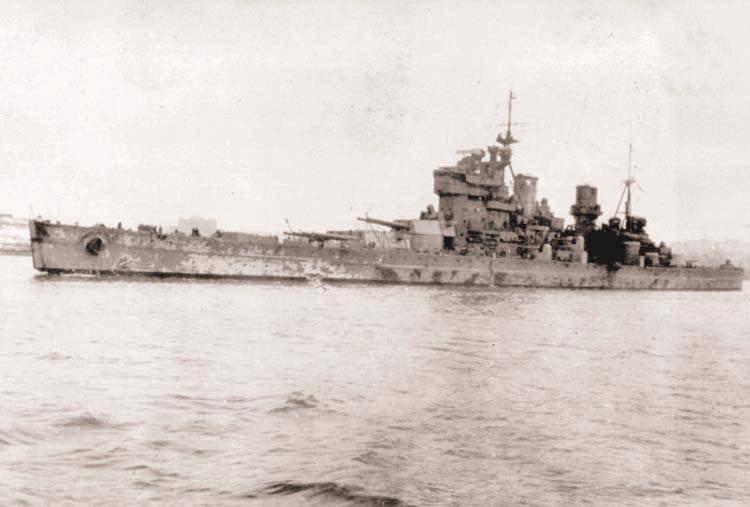
He answered the last question in the following way: LK will not regain its combat capability until the main forces join, if the interception fails; he considers it inappropriate to join the battle, while the LC has the ability to maintain the course.
Having received the radiogram of the commander of the 1 th cruiser squadron, the Admiralty realized that "Bismarck" was still very dangerous.
The evening was coming. Bismarck and Prinz Eugen continued to go to S, and Suffolk, Norfolk and Prince of Wales continued to follow them, without losing visual contact.
In 17.11, in the event of a sudden attack by the Germans, the British ships rebuilt: "Prince of Wales" stepped forward, a "Norfolk" took place behind its stern, covering the LC from the "out of service" fodder tower. During this rebuilding, КРТ did not see the German LK, but they reported from Suffolk: “Bismarck” is in 152 ° bearing at a distance of 16 miles, you (i.e., Norfolk) - in 256 ° bearing at a distance of 12 miles.
In 18.09, the signalmen of Rear Admiral W. Wake-Walker flagship saw "Suffolk", the flagship ordered to give him a signal to approach the 5 miles.
"Bismarck", as the British believed, tried to watch for "Suffolk" in the fog, and when he began to turn on Ost, opened fire. This happened in 18.41.
As it turned out, Admiral G. Lutyens acted covering the flight of Prinz Eugen.
The second combat contact. The escape "Prinz Eugen"
German VL fell with an undershoot, but close enough to knock out the rivet of the onboard plating in the stern of the English КРТ by breaking a shell.
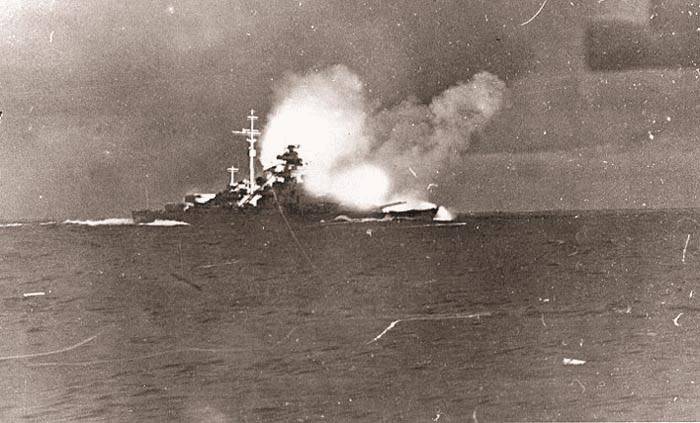
Before hiding behind the smoke curtain, Suffolk managed to answer with nine shots from the side.
Seeing that Suffolk had been attacked, Norfolk immediately changed course and rushed towards the enemy, opening fire on 18.53.
The guns "Prince of Wales" earned five minutes earlier, and for 8 min. he managed to make 12 volleys without reaching a single hit. However, this shooting was enough for two main caliber guns to fail (due to defects in the turret AU).
Bismarck did not intend to resume the fight, and Rear Admiral W. Wake-Walker was quick to inform Prince of Wales that, before Admiral J. Tovi’s approach, he also did not intend to come into contact with the enemy.
So, the skirmish turned out to be transient: “Bismarck” began to move away again, and “Prinz Eugen” released without any instructions, using a snow charge, disappeared from prosecution.
The British cruisers went further anti-submarine zigzags - they entered the area of operations of the German submarines.
The alignment of forces in the evening 24 May
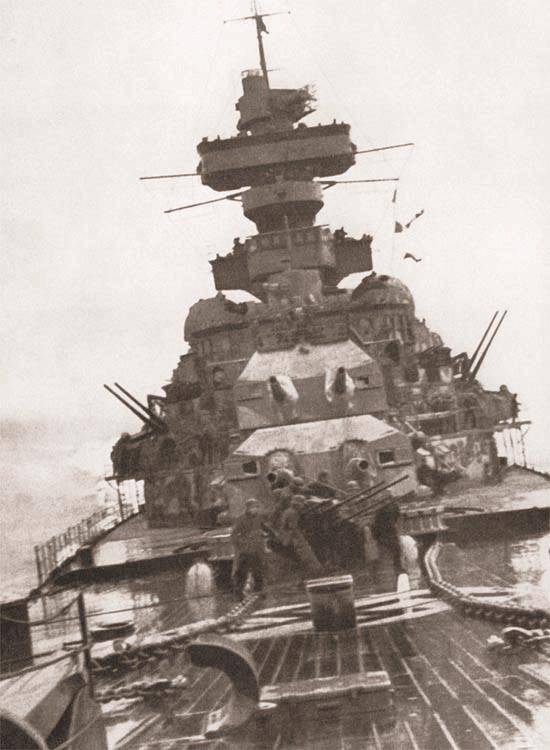
On 20.25, the Admiralty sent a radiogram to the ships describing the situation on 18.00 24 in May. She looked like this.
Opponent - 59 ° 10 ′ N, 36 ° W, course - 180 °, move - 24 node; Norfolk, Suffolk and Prince of Wales maintain contact with him. The fleet commander of the metropolis is King George V, Repulse, Victorious and the 2 cruiser squadron (the latter separated from Admiral J. Tozi in 15.09) 58 ° N, 30 ° W.
KPT "London", escorted from Gibraltar transport "Arundel Castle" and located at the coordinates of the coordinates 42 ° 50 N, 20 ° 10 W, was ordered to leave the transport and follow the approach to the enemy. LC “Ramilles” - approximately 45 ° 45 ′ N, 35 ° 40 ′ W - bypasses the course of the enemy with W.
The Manchester, Birmingham and Arethusa CRLs left their position at the northeastern tip of Iceland to replenish fuel supplies.
LC “Revenge”, which left Halifax in 15.05, follows the 6-nodal speed with the low-speed escort HX 128 (44 transport). KRL "Manchester" is approximately at the point 45 ° 15 ′ N, 25 ° 10 ′ W.
So, not counting the destroyers, 19 battleships (including “Force H”) - 3 LC, 2 LCM, 12 KR and 2 AB “worked” to capture the German LC.
Attacks "Victorious"
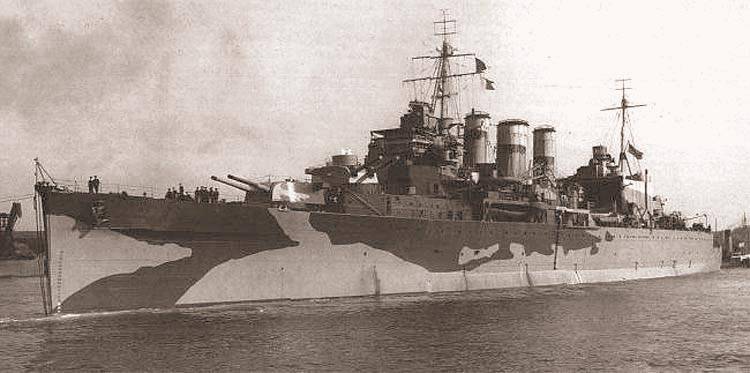
Admiral J. Tovey, who was striving above all to detain the enemy, sent AB "Victorious" ahead, so that he tried to force Bismarck to reduce the course by attacking his torpedo bombers. On the AB, which had not yet had time to gain combat experience, there were only 9 strike aircraft - these were the “Swordfish” of the 825 squadron. There were still 6 fighter "Fulmar" 802-th squadron, the rest of the place in the hangar was occupied by partially dismantled fighter "Hurricane", which should be delivered to Malta.
The commander-in-chief's message that aircraft with “Victorious” about 22.00 will attempt to attack “Bismarck”, sent to 14.55, Rear Admiral U. Wake-Walker read to 20.31. He hopefully began to expect the emergence of aircraft, which, according to his calculations, could be above the target around 23.00.
Opponent for some time lost sight of, but in 23.30 “Norfolk” momentarily “caught” the target at a distance of 13 miles. After 13 min. torpedo bombers appeared in the sky.
* * *
After a short battle between the ships of Rear Admiral U.Wake-Walker and Admiral G. Lyutyens, it became obvious that Victorious could not get to the “Bismarck” on the 23.00 miles by 100.
Then the commander of the 2-th cruiser squadron Rear Admiral E. Curtis (ATBCurteis), holding his flag on the Galatea CRL, decided to raise the aircraft around 22.00 when the distance to the target would be 120 miles, and gave the appropriate order to the commander AV for the rank 2 captain G. Bovilu.
A fresh northwest wind blew when at 22.08 "Victorious" changed course to 330 ° and reduced the course to 15 nodes so that the torpedo bombers could take off. The weather was, as they say, "you can not imagine worse." It was daylight, but dense clouds and rain created twilight. The flight deck swayed between the foamy crests of the waves and the clouds rushing low in the leaden sky, watered by cold rain.
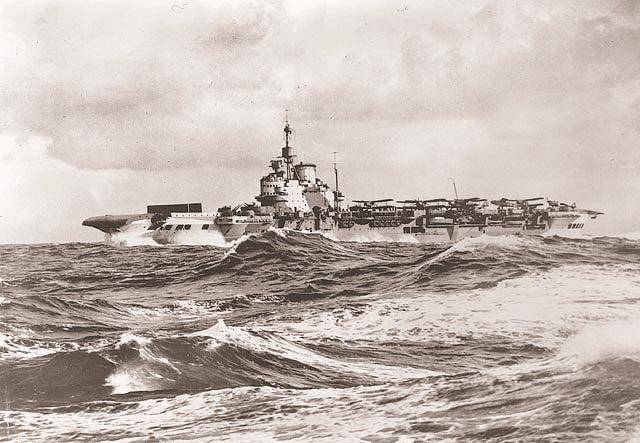
In 22.10, nine torpedo bombers of the 825 squadron flew off the AB deck and disappeared into the clouds. It was led by Lieutenant Commander Eugene Esmonde.
Having gained 1,5 altitude thousands of feet (about 460 m), the squadron lay on the course 2258. The aircraft flew at a speed of about 160 km / h, but the 120 miles, which separated the British AV and the German LC, the squadron overcame almost two hours.
In the conditions of dense low clouds, the approximate coordinates of the target that the pilots received before departure were clearly not enough.
Fortunately for the British, for the torpedo bomber "Swordfish" by the time managed to create an aircraft radar. The ASV Mk.10 radar antenna, placed in the fairing, was suspended under the nose of the fuselage, in the place of a torpedo, therefore, the radar-equipped aircraft could not perform the role of percussion.
At about 23.27, the radar operator, bent over the indicator screen in the second booth of one of the Swordfish 825 squadron, found a target mark - right on the course in 16 miles. Three minutes later, a “Bismarck” was seen breaking through the clouds, following the course of 160 °, but was immediately lost sight of it, as the clouds quickly closed up.
The English ships chasing the Germans were to be to W from them, so the squadron changed course to NO, then turned left.
Soon, the radar "caught" two ships, left and right along the course - it turned out to be a pursuit group, and Suffolk sent torpedo bombers to Bismarck, which was ahead of it in 14 miles.
The 23.50 radar operator saw the target right on the course. The squadron went down and, breaking through the clouds, prepared to attack. However, instead of the German LC, the pilots saw in front of them a US Coast Guard ship "Madoc" lying in drift. Bismarck, which turned out to be 6 miles to the south, noticing the planes, immediately opened heavy barrage fire.
There was no time left to rebuild. All eight * aircraft, each carrying one 18-inch torpedo equipped with a dual-channel proximity fuse and set to a depth of 31 foot (9,46 m), rushed into the attack from one direction.
* - In the secret reports of the Admiralty on the number of aircraft attacking “Bismarck”, a note was made: “One aircraft lost contact (with the others) in the clouds”. This was probably done in order to hide the "unarmed" equipped Swordfish radar
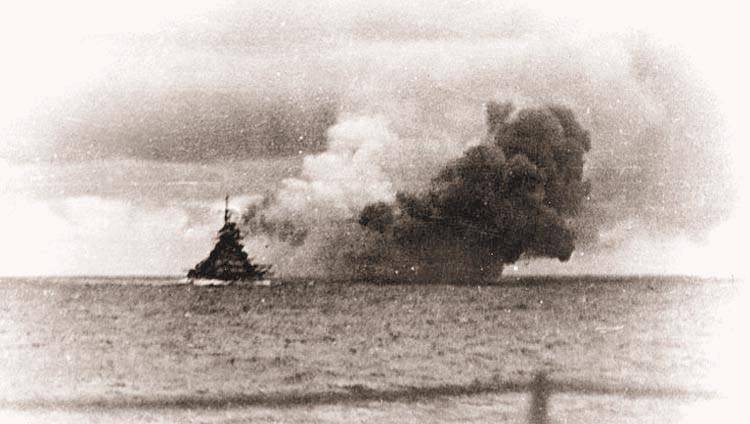
At exactly midnight, three cars simultaneously dropped torpedoes, sending them to the left side of the LC in the area of the mid-section. The next three, dropped in a minute by the 2 group, which went a little further, went to the front of the hull, "Bismarck". The 7 machine threw its torpedo into the area of the bow superstructure of the LC, and the 8 of the Swordfish, bypassing the Bismarck, dropped the torpedo from the starboard side of the 0.02.
It was this torpedo dropped last hit the left side of the LC in the area of the navigating bridge: two Fulmar fighters, raised from Victorious in 23.00 and observing the results of the attack, reported that they see black smoke rising from the bow of the LC, and he himself reduced the course .
Although the armor belt survived, a gap appeared between the plates and in the casing, which made Bismarck temporarily reduce its travel to 22 nodes.
The second pair of fighters, soaring with "Victorious" in 1.05, despite all the efforts could not detect the enemy.
When in 0.52 the sun disappeared beyond the horizon, the squadron of Lieutenant Commander Y. Esmond passed less than half the way back. Unfortunately, the driving beacon on the "Victorious" failed, and the planes passed by the AB, not noticing its landing lights in the shade of rain. I had to use to drive the radio range and signal lights.
Finally, around 2.00 aircraft requested landing. Landing spotlights and flight deck lights were turned on at the AV. In 2.05, all the cars landed safely - despite the fact that the three pilots had never landed on the AB at night.
But the fate of the two fighters "Fulmar" was sadder. They were expected to 2.50, giving circular radar pulses and rotating beams of searchlights, but the aircraft did not appear. The darkness was already complete, and Rear Admiral E. Curtis. who feared German submarines, had to give an order to the AV to stop waiting and count the fighters as dead. The planes really died, but the pilots after a few hours in the water on the life rafts boarded the American ship.
The third combat contact. The enemy is slipping away again
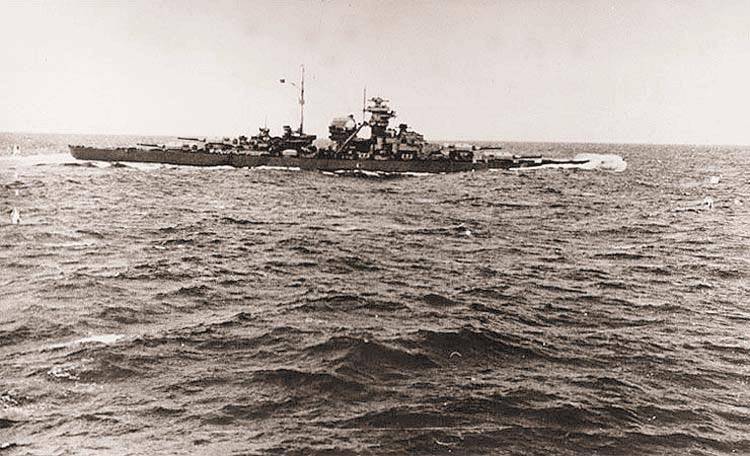
While the torpedo bombers attacked Bismarck, Norfolk spotted the ship in the direction of SW.
Rear Admiral U.Wake-Walker immediately ordered to open fire on the detected target, considering it to be "Bismarck." However, "Prince of Wales" had the opportunity to make sure that the target is an American cutter "Madoc". Fortunately for the Americans, while the British were preparing to shoot, contact was lost.
On 1.16, turning to 220 °, Norfolk suddenly discovered “Bismarck” by 204 ° bearing at a distance of 8 miles. A short artillery duel followed.
"Norfolk" and "Prince of Wales" turned left to open their guns area for firing, and pointed them at the enemy. In 1.30, using data from a radio rangefinder, the English LC from the distance of 20000 yards (18.200 m) produced two volleys. Bismarck also responded with two, its shells lay down with a large undershoot.
After that, the British lost the enemy again, and Rear Admiral U.Wake-Walker ordered the Suffolk KPT, whose radar had the most reliable readings, to search independently, and he followed the LC with him.
In 2.29, “Suffolk” discovered “Bismarck” at a distance of 20900 yards (19000 m) using 192 ° bearing.
The German LC went on the course of the 160 ° 20-node junction.
The night was clear, visibility reached 6 for miles, and Suffolk went anti-submarine zigzag — probably, its commander decided that the risk of losing contact again was * less than the risk of being torpedoed by the German submarine.
* - Performing an anti-submarine zigzag (30 °) took about 10 min.
In his order issued after the end of the operation (S.V.04164, r.18), the commander of the Metropolitan Fleet wrote that the loss of contact with “Bismarck” was “... mainly a result of self-confidence. The radar worked so steadily and gave such accurate testimony that the commander had a false impression of security ... Suffolk pursued the radar radar detection range and lost contact in that part of the zigzag that took him further away from the target. At that moment, when the cruiser turned left, the enemy turned sharply to the right and pulled away from the pursuit. ”
Indeed, in 3.06, radiometrists recorded a “Bismarck” still bearing. But this contact was the last - the British lost the German LC. “Prinz Eugen” they last watched 24 on May at 19.09.
However, this fact didn’t happen right away. Only in 4.01 with “Suffolk” was transferred to “Norfolk” a semaphore, the content of which was as follows: the enemy either turned on Ost, being behind the stern of the cruiser, or changed course to W; Acting on this assumption. In another 10 min. Captain Ellis ordered a cipher message to be sent to notify the flagship that he had lost contact on 3.06. The commander of the 1 cruiser squadron read it in 5.15.
In 5.52, Rear Admiral W. Wake-Walker asked Admiral J. Tovi and Victorious about the possibility of aerial reconnaissance.
After analyzing the navigational laying, W. Wake-Walker came to the conclusion that, around 3.10, Bismarck made a right turn. Based on this, at dawn, he ordered Suffolk to search for W and sent encryption to Admiral J. Tovi in 6.05: “The enemy is lost in 3.06. Suffolk aims to search for W. In the afternoon, Norfolk will join Suffolk, and Prince of Wales will move closer to the Metropolitan Fleet. ”
The encryption was taken on "King George V" two minutes later. It became obvious that the “hot meeting” expected for 9.00 would not take place ...
Uncertainty again
Having lost the “Bismarck” before the dawn of 25 in May, the British were in a very difficult position. There were several assumptions about the intentions of the enemy, and in order to verify each of them, it was necessary to send ships. But the main thing is time, it could not be wasted.
In 6.30, when it finally dawned and visibility became good, Norfolk followed Suffolk, which, while searching to W, was following the 25 nodal course of 230 °. "Prince of Wales" went to S, to connect with Admiral J. Tovi, considering that "King George V" and "Repulse" were at the point 54 ° N, 34 ° 55 ′ W. In fact, they were much further to SW .
In accordance with the Admiralty’s instructions received at night, Rear Admiral E. Curtis changed the course on XRLUM at Galatea at 5.58 and headed for the point where Bismarck was last seen and at Victorious for 7.30 prepared for aerial reconnaissance direction to East.
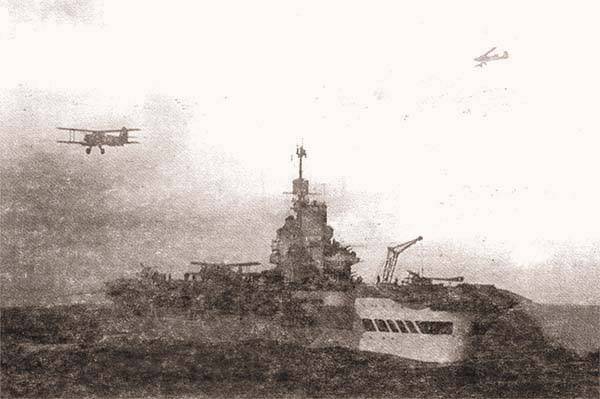
However, the order of the metropolitan commander-in-chief of the Fleet forced the plan to be corrected: the ships of the 2 cruiser squadron and Victorious were ordered to search for NW from the point of last contact with the enemy.
The Fulmar fighters were already flying at night (the last car landed at 4.00), moreover, two of them did not return to AB.
The fighter pilots did not have a shift, therefore, having received the order of the commander of the 7.16 cruiser squadron at 2, the rank 1 commander G. Bovel was forced to decide to send Swordfish aircraft for reconnaissance, whose crews could be replaced.
In 8.12, seven cars one after another broke away from the flight deck and began a search in the 280-40 ° sector for a distance of 100 miles. The Victorious itself, as well as the Galatea, Aurora, Hermion and Kenya CRLs that accompanied it, also observed in this sector.
So, having found nothing during the almost 4-hour flight, the 11.07 aircraft returned to their AV, and one of the cars that made an emergency landing on the water was missing. Fortunately, the unfortunate "Swordfish" was brought alongside a drifting life raft, in which there were no people, but there were emergency supplies of provisions and water. The crew spent the day on the 9 raft before being raised aboard a passing ship.
In 10.30, King SW V received a radiogram from the Admiralty with a series of radio directional reports, which, as reported in the cipher, probably gave a position to the German LC — intercepted signals were identified with those coming from Bismarck immediately after the torpedo attack * of the aircraft with "Victorious".
* - The transmission of a long radiogram from the LC was recorded by British ships on 2.58 on May 25.
Only an even longer radiogram, the transmission of which began on board the Bismarck on 8.52, lasted more than half an hour (Admiral Lyutyens was sure that his tracking was not interrupted, and therefore decided to report in detail to his command about the situation), allowed the direction finding to determine his place .
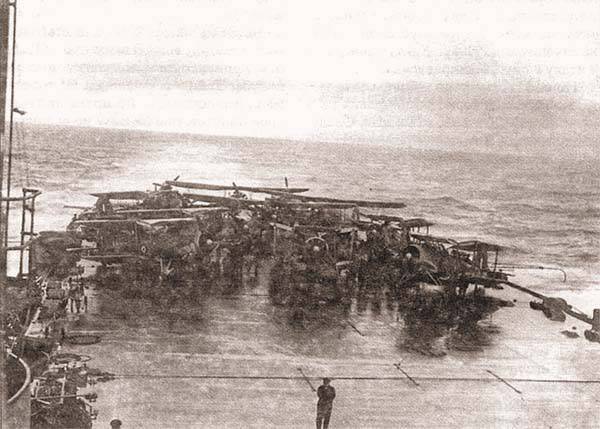
Having laid them on the map, Admiral J.Towy’s marching headquarters received coordinates that were significantly different from those obtained on the assumption that the Bismarck was heading for the North Sea.
Describing a circle around the point 57 ° N, 33 ° W, the radius of which corresponded to the distance that the Bismarck could cover since the moment of direction finding, we obtained the area of its equally probable location. In order to intercept the enemy, the commander-in-chief, after notifying all the ships, turned on the course of 55 °, making 27 nodes towards the “Faro-Icelandic hole”.
King George V walked alone - back in 9.06, the Commander of Repulse, Captain 1 of the rank of W. Tannant, received permission to go to Newfoundland for bunkering. CRL "Galatea", "Aurora" and "Kenya" with the information of Admiral J. Tovi immediately turned on the course 85 °.
In 10.23, from London to the commander-in-chief of the fleet of the metropolis, the commander of Force H and the commander of the 1 cruising squadron, finally, a more clear indication was sent: to proceed from the assumption that Bismarck should go to Brest.
On Renown, located at 41 ° 30 ′ N, 17 ° 10 ′ W, this message was rehearsed in 11.00, and after 8 it was min. "Rodney" received several 8 other instructions: to act on the assumption that "Bismarck" goes to the Bay of Biscay. Doubts did not leave the supreme command of the British fleet.
The Admiralty, using one-way radio communication, at this stage of the operation, did everything possible to provide the ships with the most accurate data as soon as possible. On this depended the preservation of the radio silence mode.
In 14.28, the Admiralty revoked its instruction given earlier by the 1 captain of the Dolrimpl-Hamilton rank, and this time ordered Rodney to act on the condition that the German LK was sent back to Norway through the strait between Iceland and Ireland. *
* - In 13.20 with the enemy, it was possible to establish a stable RL contact, which gave its coordinates, however, with an accuracy of up to 50 miles - 55 ° 15 ′ N, 32 ° W.
In 14.19, the ciphering of the commander-in-chief, which he received at 15.30, left London. But even this did not become the basis for an unequivocal order - doubts remained. Only in 19.24 from London, another encryption was sent to Admiral Tovey, which said that the Admiralty regards the purpose of the movement of the German LK to the west coast of France.
Another 2 hours later, at 16.21, London received a question from Admiral J. Tovey, who was still going to the East with a 25-nodal course, by 80 °: “Do you think the enemy is heading for the Fareram?”
With the onset of the evening, the Bismarck movement in Biscay became stronger, and the Admiralty 18.15 canceled the directive sent to 14.28 and stated: the enemy’s “destination” was the French port.
When Admiral J. Tovey in 18.10 ordered the captain of the 1 rank Patterson to turn to SE, he still did not have accurate information about the enemy.
On 21.10, “Victorious”, located at 57 ° 59 ′ N, 32 ° 40 ′ W coordinates, flew 6 “Swordfish”, which searched the 80-180 ° sector within 100 miles from AV. The planes have returned the next day, in 0.05.
Coast Guard aviation seaplanes made several reconnaissance flights along the possible route of the German LC to Brest, but also found nothing.
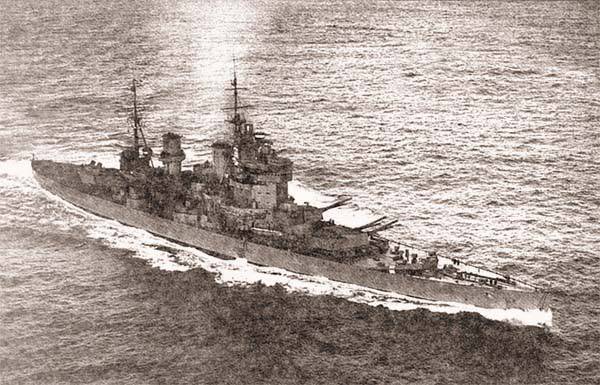
By that time, the lack of fuel had become the most serious problem for British ships. The Repulse had already left for Newfoundland, the Prince of Wales was following to Iceland; "Victorious" and "Suffolk" reduced the course and went on economic regimes. KRL "Hermion", which has less than 40% fuel left, had to be sent to the Hvalfiord, the remaining cruisers, in order to save, were forced to limit the course of the 20 th units. In tanks of the flagship of the commander-in-chief of the Fleet, the metropolis remained about 60% of the oil reserves.
Around midnight, Admiral J. Tovey ordered all commanders to save fuel, which meant a directive decrease in speed.
By the morning of May 26, the lack of fuel on British ships had become crucial - they had been at sea for four days. In the Admiralty, exotic projects were born, such as shuttle flights of PBY "Catalina" flying boats, equipped with fuel tanks ...
The problem of fuel most of all influenced shipboarding. AB “Victorious” was in great need in escorting EM, but LC Rodney was even more risky.
The Admiralty's attention was attracted by the ships of the 4 th EM flotilla, which escorted the convoy WS8B. At 2.00 on May 26, captain 1 of rank Philip Vayan (Philip L.Vian), who held the flag on “Cossack”, received an order to leave the guarded transport convoy with troops and head for NO, to join the Rodney. The EM Zulu, Sikh, Cossack, Maori and Piorun were to play a very important role in the next phase of the operation.
Force H - Renown LKR, Ark Royal AB and Sheffield CRL - also followed without an escort, which was released back to Gibraltar back in May 9.00 25.
Two hours later, receiving an Admiralty radio message stating that the Bismarck was on its way to Brest, Vice-Admiral J. Somerville ordered to prepare for raising reconnaissance planes. “Force H” was at the breadth of Brest, and the latest information about the German LCs Scharnhorst and Gneisenau that were there related to 23 in May. *
* - The Admiralty had Brest aerial reconnaissance data on 19.30 25 in May, which reported that both ships were still there. The corresponding radiogram in Gibraltar, intended to be transmitted to Renown, left London for 21.08. When they received it in Gibraltar at 22.26, Renown had already switched to another wave half an hour ago and could not accept it. A radio session on another wave took place only in 0.34.
The weather has deteriorated since last evening, the wind was more than strong, the squadron speed had to be reduced to 17 nodes. AB was walking through the north-west storm, the height of the waves reached15 m. Airplanes lifted from the hangar in their arms were dragged through streams of water to the launch positions. In 7.16, the combat air patrol fighters took off from Ark Royal, and the 8.35 Swordfish launched their search in 10. They landed at 9.30, finding nothing.
The general course of the enemy is determined
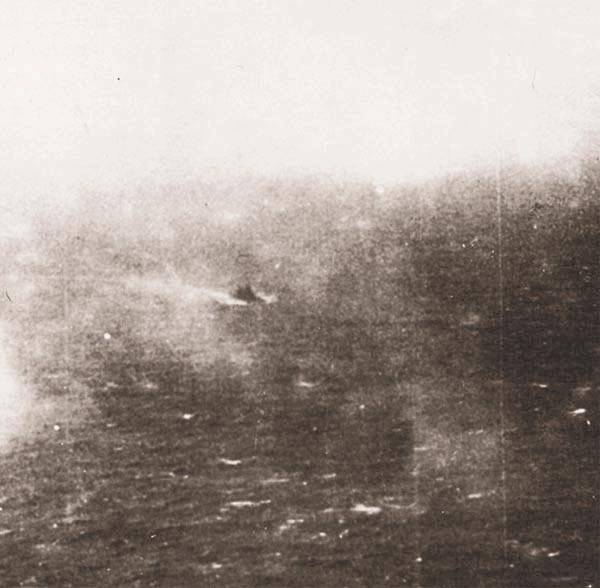
In 10.30, PBY "Catalina" Z209 seaplane, flown from Lough Erie in Ireland, piloted by Dennis Briggs (Dennis A.Briggs), discovered an oil trail left by the German LC due to injuries resulting from the impact of two shells from "Prince of Wales" 24 May. Soon the 2 th pilot, an American Leonard Smith (Leonard V. Smith), saw five miles away the Bismarck itself, following the course of 150 °. "Catalina" came under fire anti-aircraft guns LK and received damage. As a result, contact has been lost in 10.45. But now its general course was precisely known - “Bismarck” was going to Brest.
In 10.43, this report was received by the flagship of the Metropolitan Fleet Commander, and Renown - five minutes earlier.
About two hours later, in 11.15, two Swordfish with Ark Royal confirmed the information by finding Bismarck in the 25 East of its previous position. True, one of the pilots reported on the detection of the CD, but not the LC.
So, Admiral G. Lutyens was about 690 miles from the target. If Bismarck kept the 21 hub move, then it could reach Brest in 21.30 on May 27.
Admiral J. Tovi on King George V, which was separated from the German flagship 130 for miles, had a real chance to catch up with the elusive LC. But the matter consisted not only in distance and speed - the position of the opponents changed every hour, and not in favor of the British.
Bismarck was approaching its coast, and therefore with minimal risk could produce the fuel remaining in its tanks. He could also count on air support. The British went to the enemy coast, being forced to save in every possible way the fuel necessary for the return, being exposed to the increasing risk of becoming the targets of attacks by German aircraft and submarines.
Of the major combattants, Renown was the closest to Bismarck, but after losing Hood, no one wanted to throw him into battle until Rodney and King George V approached - just in case the prohibition to go into battle alone they radioed Vice Admiral J. Somerville back in 10.52 (he received it in 11.45).
Somerville could not ignore him, therefore, taking a position in the 50 miles of Bismarck, he sent airplanes for reconnaissance throughout the day. Three times (from 12.30 to 15.53; from 16.24 to 18.50 and from 19.00 to 21.30), aerial reconnaissance with Ark Royal made and maintained visual contact with the target. All this time, the AV was in readiness for the immediate application of a torpedo-bombing strike.
Aircraft of the Coast Command also continued reconnaissance flights. In 12.20 "Catalina", M420 discovered the EM of the 4 fleet.
Having received a message from board Z10.54 about contact with the German LC in 209, the captain of the 1 rank F.Vayan, hurrying to join the ships of Admiral J.Tovi, decided to change the course to SE sharply, having rushed to intercept.
Attack "Ark Royal"
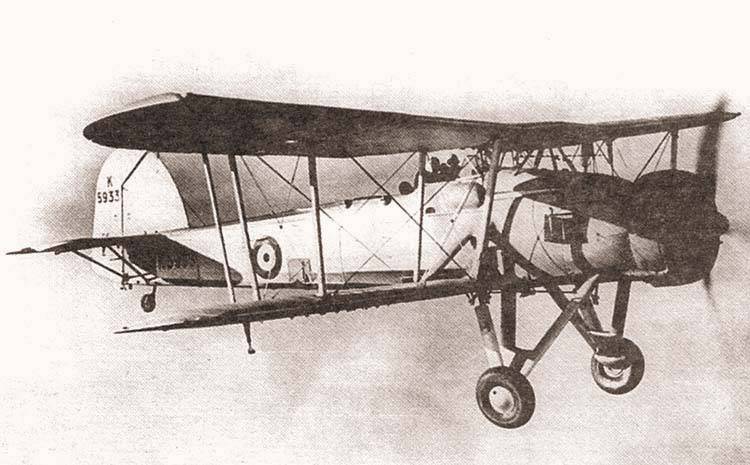
In 13.15, Vice-Admiral J. Somerville ordered a semaphore commander of the CRL "Sheffeild", Captain 1 of rank Larcom, to separate from Force H and get closer to the enemy.
This signal was not duplicated for Ark Royal, with very serious consequences. Half an hour later, the flagship radioed to the Admiralty about this order, the radio was received on the Ark Royal, but they were not in a hurry to decipher, because the report came from Admiral Somerville and was not intended for AB.
One way or another, but the pilots of airborne patrols did not suspect that Sheffield had left a Force H order. Confusion appeared in their reports about the detected ships - LK or KR? Recall that the British did not yet know about the flight of “Prinz Eugen”, and anyone found in the area of the movement of the enemy of the Kyrgyz Republic was completely “legally” identified as enemy.
However, aircraft torpedoes on Sarpfish torpedo bombers prepared for departure were set to a depth of 30 feet, which, according to the British, corresponded, more precisely, exceeded * Bismarck draft, if torpedoes Mk.XII had non-contact magnetic detonators, they had to explode, passing under the keel of the target.
* - This circumstance requires separate careful consideration.
The fact is that the Germans launched disinformation about the true draft of the “Bismarck” on all channels. And if the initially underestimated value of rainfall of the LC only “justified” the underestimated official displacement of the ship, then for specialists arms This value, “legalized” in secret military manuals, determined the installation of torpedo modes before the attack on LK.
It becomes clear how serious the difference between the true and “legalized” draft has become - maybe even in a fraction of a meter. After all, damage from a non-contact explosion of a torpedo under the keel of the LC could be immeasurably greater than from a contact explosion in the cheekbone area. This is the situation that happened when AB “Ark Royal” was torpedoed - in fact, it died from a non-contact explosion of one German torpedo.
In 14.50, 1 rank captain Loben Mound gave the command to take off the strike team. One by one, the 15 Swordfish went up from the Ark Royal flight deck and headed for S. One plane was immediately forced to return due to a failure that had been detected after the take-off of the fault.
Since the weather and the height of the clouds did not allow us to count on timely visual detection of the target, all hopes were pinned on aircraft radars. They then played a cruel joke with the pilots.
Having found a mark of a large target on the indicators, which was located approximately in 20 miles from the expected position of the German LC, the squadron, upon command, went into the attack without hesitation, being in complete confidence that it was “Bismarck”. Only after resetting the torpedoes that happened at 15.50 did the pilots, with considerable surprise, find that they had worked ... on the Sheffield KRL!
The thing was that the pilots were briefed before the flight and informed that there were no other ships between the continuing pursuit of the Bismarck KP Norfolk and Suffolk and the LC itself. Therefore, they attacked the Sheffield, which happened to be “in the wrong place” on the move, and saved only timely and very energetic maneuvering.
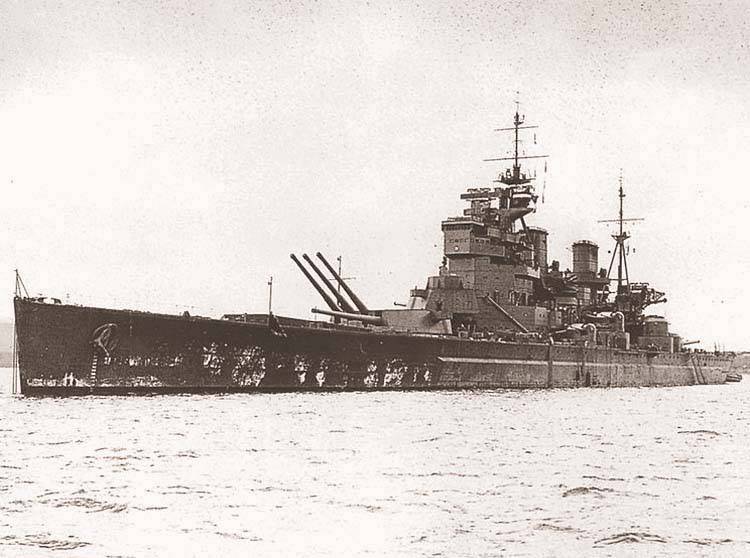
One can only be surprised at the skill and endurance of the captain 1 of the rank of Charles Larcom, who, not forgetting to order his gunners not to open fire on aircraft, managed to save the ship to which they threw 11 (!) Torpedoes. True, three of them exploded when dropped into the water, but the other three - near the CRL stern. From the rest, “Sheffield”, which immediately increased the turn to full, managed to dodge.
The frustrated and angry flyers had to return to the AB in order to hang up the torpedoes and replenish their fuel, which they did in 17.20. Returning, the aircraft noticed in 20 miles to W from Forte H the approaching EM 4 of the fleet.
About half an hour later, Sheffield discovered Bismarck at 48 ° 30 ′ N, 17 ° 20 ′ W and, giving Vice Admiral J. Somerville its place, took up a position in 10 miles along the stern of the enemy.
The Swordfish pair, soaring with Ark Royal, confirmed that the target this time is indeed Bismarck.
Due to the failure of the Duplex fuses, the torpedoes re-suspended from the aircraft were equipped with conventional contact fuses, and the depth of the stroke was set to 22 feet (6,7 m). For takeoff, 15 machines were prepared: four - 818 squadrons, as many - 810 and seven - 820 squadrons.
The command of the shock group was assigned to the captain 2 of the rank of TP Kould (TPCould).
Over the sea, an almost hurricane 6 point northwest whistled and it rained. The height of the clouds was about 600 m. At times, the 15-meter waves rose above the flight deck, the AV experienced a strong pitching motion. The deck crew had to act very quickly, otherwise there was a strong risk that the planes would simply fall overboard.
In 19.10, captain 2 of rank T.Kud reported on the readiness of the group for takeoff. One by one, the 15 "Swordfish", at the risk of sinking into the wave when the AV nose went down and getting a good kick from the bottom when the ship climbed the crest of the wave, took off. In the air, the planes were divided into two groups, with three links in each.
According to the orientation transmitted from Sheffield, the target was in 167 ° bearing from Ark Royal at 38 miles. The strike group received an order to fly to the cruiser, which will direct it to the Bismarck.
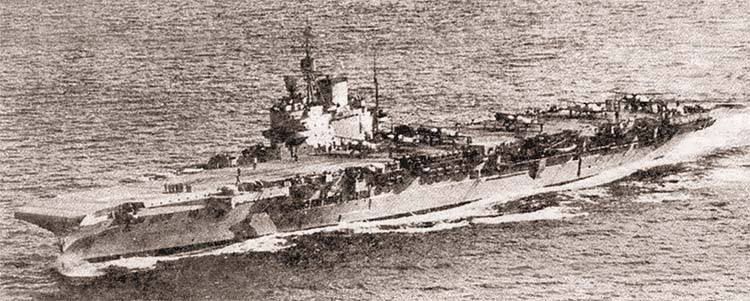
Because of the strong wind, the flight took more than half an hour. Sheffield found in 19.55, but the planes immediately lost it. We managed to establish contact with him only in 20.35 — a visual signal was sent from the KRL to the aircraft: the enemy is in 110 ° bearing, the range is 12 miles.
Shock group, lined up in links, approached the goal from the stern. Meeting on the way a small cluster of clouds, the aircraft went into a climb, divided into groups.
In 20.47, the 1 link (three cars) went down, hoping to get out of the clouds and refine the course. When the aircraft altimeter readings passed the 2000 foot mark, the group commander got worried - the cloudiness was about to end. However, a dense cloud surrounded the car and at an altitude of 1,5 thousand feet (450 m), and only at the 300-meter mark torpedo bombers "fell out" of dense gray veil, and the pilots saw "Bismarck" four miles ahead of the course.
With the 1-m link, there was one “Swordfish” from 3-th. Convinced that the distance was still too great, Commander T. Cood ordered his unit to re-gain altitude and enter the clouds. In 20.53, four torpedo bombers began to dive at the target, dropping their torpedoes under very intense barrage and seeing that one of them had reached the target and exploded.
The 2 link, in which two planes were left, lost contact with link # XXUMX in the clouds. Climbing to the height of 1 feet (9000 m), the pilots navigated according to the radar and attacked the LC from the starboard side, dropping two torpedoes that went into the middle part of the Bismarck hull.
One torpedo might hit the target.
The third plane of the 2-link, "lost" in the clouds, returned to the CRL "Sheffield", again received target designation and attacked the target independently. He entered Bismarck from the nose and lay down on the combat course from his left side, sending a torpedo to the middle part of the LC. Despite the strong fire, the pilot stood the car on a combat course, and the torpedo hit the left side of the target.
4-link after 3-m entered into the clouds with climb, but icing began on 2000 m. Entering the peak, at the height of 600, the 4-th link aircraft found a “window” in the clouds, where they were joined by the second “Swordfish” from the 3-link. After a moment, the pilots saw the Bismarck, who attacked the 2-link from the starboard side.
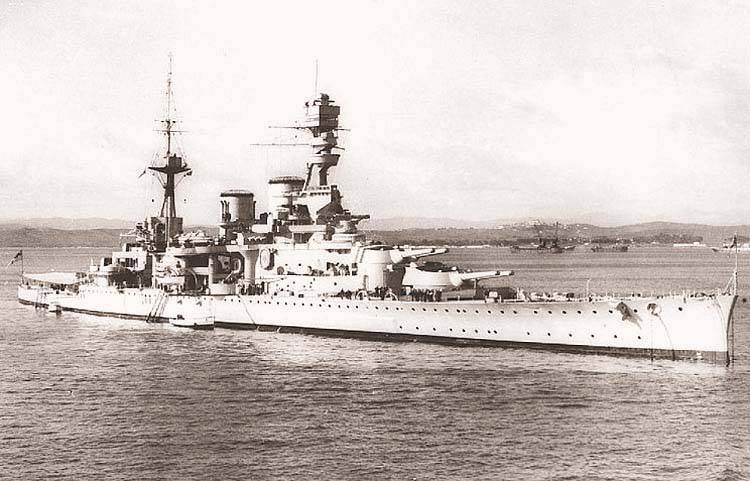
Four aircraft circled the LC from the stern and began to swoop down on it through a small low cloud, simultaneously with the 2 th link attacking from the opposite side. The torpedoes dropped by them did not hit the target, but the planes themselves came under the most severe shelling - the machine, which had the number 4С, received more than a hundred holes, both crew members were injured.
The two cars of the 5 link are also “lost” in the clouds. Rising to a height of more than 2100 m, the aircraft began to become covered with ice. The 4K machine went down to the 300 m, finding the target directly below it, then under the anti-aircraft artillery fire it rose again, having seen the torpedo hit on the starboard side of the LC. Then, retiring five miles, this Swordfish took up a position to attack the nose of the Bismarck from the starboard side and, flying over the very crests of the waves, dropped the torpedo from a distance of about 1800 m, but without success.
The second “Swordfish” of the 5 link lost its lead during a dive through the cloud, “falling out” from there directly above the LC tank, fell under concentrated fire, and after two unsuccessful attempts to attack it was forced to get rid of the torpedo ...
One of the two airplanes of the No. 6 link attacked the Bismarck from the starboard side and dropped its torpedo from the 1800 m distance, aiming at the middle part of the hull. The torpedo did not explode. The second machine lost its target, but, after flying for targeting to the Sheffield, returned and, on a low-level flight from the traverse direction, attempted to attack the starboard of the target. Intense and accurate fire forced the pilot to turn off the combat course ...
The attack ended in 21.25. The planes attacked the “Bismarck” 13 with torpedoes (two were dropped unaided), three torpedoes hit the target: the first damaged the left propeller shaft, the second stuck the rudders at 12 ° to the left side. Bismarck lost the ability to control and began to describe circulation. * The third torpedo exploded in the area of the aft superstructure. It was a success!
* - The reconnaissance aircraft flying in pairs during the whole day of May 26 (total 8 “Sworfish”, the last couple landed at 23.25), observed that “Bismarck” described two complete circulations.
"Bismarck" snaps
Sheffield was still hanging on the tail of the German LK when, at 21.40, Bismarck, turning left, opened fire and made 6 very accurate volleys with the main caliber. There were no hits, but a close gap killed three and seriously wounded two sailors. KRL turned away, noticing the Cossack and other ships of the 4 Flotilla approaching from the EM. Sheffield gave them the approximate coordinates of Bismarck, while he himself went a fair distance and began to follow a course parallel to him.
* * *
"King George V", on which 26% fuel was left at midday on May 32, making 25 nodes, went to SE. When Rodney joined him in 18.26, there were still about 90 miles to the enemy.
Captain 1 of the rank Dolrympl-Hamilton informed Admiral J. Tovi that due to a lack of fuel, he reduced the turn to 17.05 nodes with 22 and would be forced to turn back no later than 8.00 the next day. The commander-in-chief of the Metropolitan Fleet already understood that if the torpedo bombers with Ark Royal did not force Vismarck to slow down the course before 24.00, he would turn back himself.
In 21.42, the British LK turned "all at once" to S - in the hope that they would see the enemy in the rays of the sunset.
In 22.28, Vice Admiral J. Somerville received the message: “Bismarck” received torpedo hits.
* * *
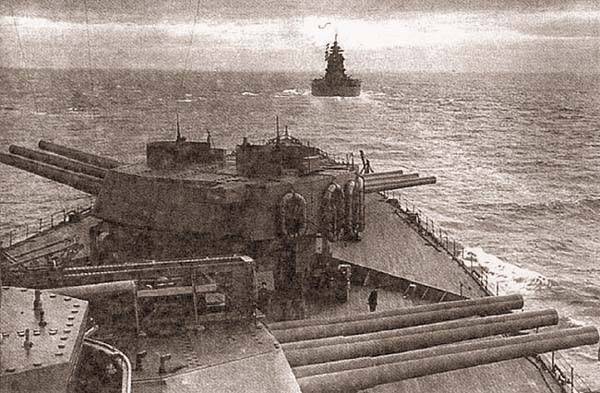
On the German LC flooded the tiller compartment. A diver descending to the compartment inspected a rudder wheel baller and found that it was impossible to repair it in field conditions.
The Bismarck team, full of jubilation after the sinking of Hood, only starting from 25 in May realized what forces were thrown to destroy the LC.
Half a day was lost due to unrealistic reports of German aircraft. Captain 1 rank Lindemann headed for Brest on the orders of Admiral Carls, who promised to meet LC with powerful forces of aviation and submarines. There was almost no fuel left in the Bismarck oil tanks, the crew made tremendous efforts to correct the damage caused by the torpedo explosion.
In 22.42, Bismarck discovered British EMs and opened fire on them.
At 22.50, Lindemann received a radiogram signed by Hitler: "All our thoughts are with our victorious comrades." In 1.40, a message was received that bombers flew to the aid, the submarines were approaching the area (one of the boats, having used torpedoes, in the afternoon of May 26 was in a very convenient position to attack Ark Royal).
When the EM of Captain 1 of the rank of F. Vayan discovered the target, the LCR “Renown” and AB “Ark Royal” were located to the NW from the enemy. Although the third attack of the day was no longer possible, the 12 torpedo bombers were prepared for departure at dawn. “Force N” changed course to N, then to W, and in 1.15 it turned to S.
Soon, Vice-Admiral J. Somerville received instructions from the commander-in-chief: to be in 20 miles south of Bismarck, awaiting the approach of linear forces.
* * *
Throughout the night, the unit was moving along a parallel course to the enemy, observing the firing of projectiles during torpedo attacks of the EM 4 flotilla.
They surrounded Bismarck all night long, attacking it with torpedoes at every opportunity. *
* - In 1.21, a four-torpedo salvo produced “Zulu” (captain of 2 rank Harry R. Grahem), in 1.28 - “Sikh” (captain of 2 rank Grahem H.Stokes), in 1.37 two torpedoes released “Maori” (captain of 2 rank Harold T Armstrong), after another three minutes, a three-shot volley fired a Cossack. In 3.35, the flagship EM repeated the attack, firing one torpedo. The last attempt took place at 6.56, it was made by “Maori”.
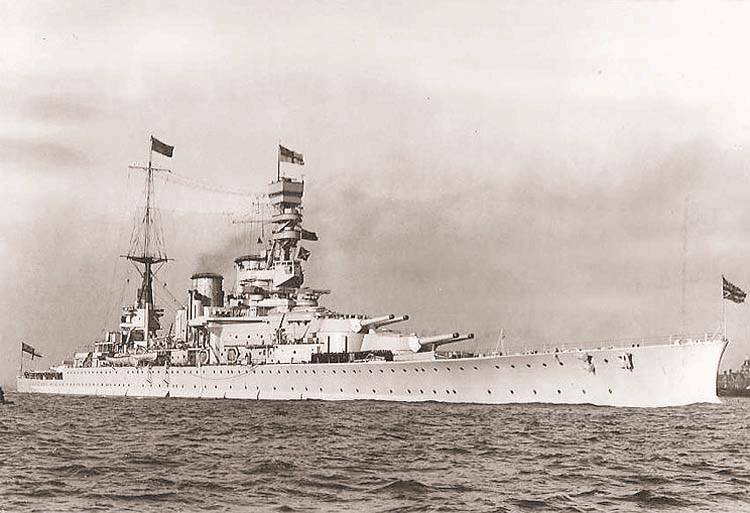
Having spent 16 torpedoes, the 4 fleet did not achieve a significant result. At the same time, carrying the Polish flag “Piorun” (Commander E.Plavsky) and “Maori” came under fire, but EM still recorded one torpedo hit in the bow of the LC - more precisely, they observed a fire in the area.
Bismarck temporarily lost its turn, but soon gave 8 nodes.
In 5.09, still in complete darkness, Walrus kicked off with King George V. Due to strong wind and rain, the plane did not find the enemy.
A dozen "Swordfish" was waiting for a signal to take off, but because of the lack of visibility after dawn, the attack was canceled.
In 8.10, N appeared “Maori”, from which the "ratier" reported that the enemy was in 12 miles from EM. Renown, which was separated from the Bismarck 17 miles, turned to SW.
* * *
May 27 morning “Bismarck” met surrounded by British EM, which followed literally every step.
Admiral Lyutyens ordered an Arado-196 aircraft to be prepared for departure - the pilot was supposed to take a watch log from the LC, a film made during the fight with Hood, and other secret documents. The bailout ended in failure - the plane fell into the water. Search for drowned documents received an order to produce U-556, and then U-74.
North-West, which was blowing at dawn hours, cleared the horizon, good visibility was established. Reports that Admiral J. Tovi received during the night showed that, despite the reduction in speed and damage to the rudders, the Bismarck retained the effectiveness of its artillery.
The commander in chief, considering that the battle on the windward courses would be the least profitable, decided to approach the enemy with WNW bearing and, if Bismarck continued to go to N, start the fight on a countercourse from a distance of about 15 thousand yards (13650 m). Further actions - according to the situation.
Between 6 and 7, a series of messages were received from “Maori” in the morning hours, in which he gave radio stations to “Bismarck”. This allowed the headquarters of Admiral J. Tovey to lay the relative course of the enemy and find out that the German LC was on the course 330 ° at a speed of 10 nodes.
In 7.08, Rodney was ordered to keep a distance of at least 6 cab. and permission to fight, maneuvering alone. Half an hour later, Rodney took a position on 10 ° bearing with respect to the flagship.
In 7.53, Rodney received a message from KPT Norfolk stating that Bismarck, going to the 7 hub move on NW, is in 9 miles.
After 37 min. visual contact was established at the 24 km distance.
In 8.43, after the direction of convergence was corrected twice by changes in course, the target was in 118 ° bearing at 25 thousand yards (22750 m).
The English LCs, which were separated by 8 cab., Followed the course of 110 °.
The battle
In 8.47, Captain 1 of the rank F. Dolrymple-Hamilton ordered to open fire on the enemy LC, a minute later Rodney supported King George V.
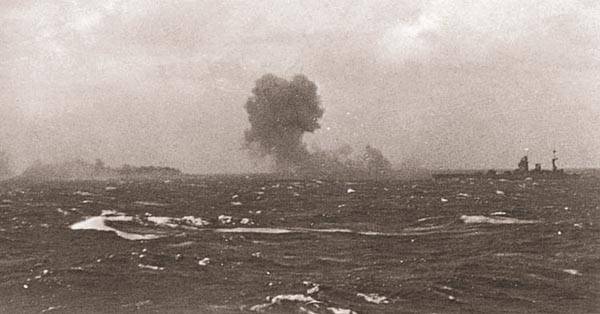
The first projectile "Rodney" raised, burst, 45-meter-long column of water. The following volleys were made by armor-piercing projectiles, which gave a much smaller splash when dropped into the water.
The German ship, which detected the enemy in 8.40, did not immediately respond, opening fire on 10 minutes, but 3 caught Rodney in its gulp. He skillfully maneuvered, on the 2 salvo having achieved the fall of his shells from the 18-meter undershoot. On the 3 salvo, in 8.54, a hit was achieved.
Smoke from a burnt cordite interfered with visual observation and fire control, but artillery radar helped.
Opponents have become so close that "Bismarck" has earned its auxiliary caliber. In 8.58, Rodney did it. In 9.02 with “Rodney”, an 16-inch projectile hit the bow of the German LC, in the area of the 1-tower of the main caliber, and after about 10 the min. in German, the LC was disabled nasal KDP.
The Bismarck turned on S and concentrated its fire on the flagship of Admiral J. Tovi, who separated 14,5 km from it.
In 9.05, the universal artillery “King George V” entered the battle, but due to the strong powder smoke, which prevented the fire control of the main caliber, after 2-3 minutes. order was given to cease fire.
For five minutes, between 9.05 and 9.15, the British flagship kept a combat distance of about 11 km.
Moving with the enemy on the S, “Rodney” fired six torpedoes from the 10 km, and Norfolk fired an 4 torpedo volley from an even greater distance - about 14,5 km. In 9.16, the bearing on Bismarck began to shift rapidly into the stern, and Rodney turned on the 16 points to get around it from the nose.
"King George V" did the same thing a minute later, and both English LCs, while on the 7.800 and 10.900 distance, respectively, resumed fire from the starboard.
“Bismarck” transferred the fire to the “Rodney” - several shells fell close, almost destroying the lazport of the torpedo tube of the starboard. However, at that moment only the 3-I tower of the main caliber of the German LC fired, the rest were silent. A fire was visible in the midship area, the Bismarck noticeably tilted to the port side.
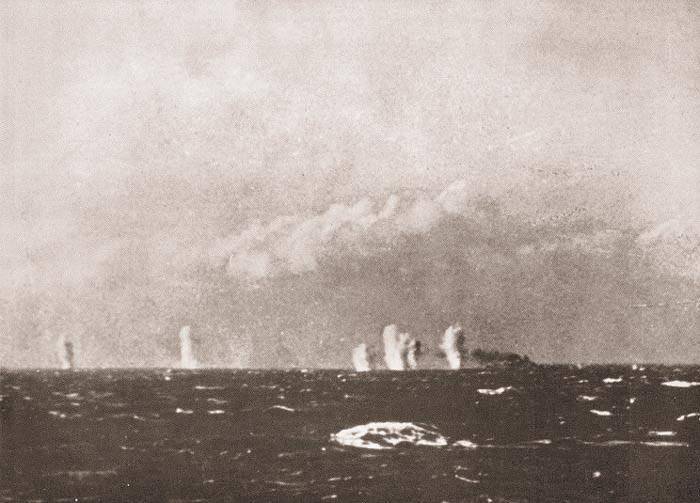
Continuing to go on the N, "Rodney" found himself in a very advantageous position not only for artillery combat, but also for a torpedo salvo. Without failing to take advantage of this, he fired two torpedoes from a distance of about 6.800 m, but both of them passed by.
The position of "King George V", which advanced further downwind, was less beneficial - smoke interfered with fire control. But much more serious were the unfortunate problems in the mechanisms of 14-inch tower installations of the main caliber - three of the four towers failed at different times (1-i for half an hour, 4-i - for 7 min., 2-i did not work around 1 min.).
As a result, for 23 min. the flagship could only use 60% of its firepower, and during 7 min. - only 20%.
In 9.25, King George V turned the 150 ° course and reduced the course so as not to go too far from the target. In 10.05, he again approached and made a few more volleys from a distance of about 2700.
Meanwhile, Rodney was maneuvering in an artillery zigzag, firing the main and auxiliary calibers from about 3600 m. He fired more 4 torpedoes, the impact of one of them was recorded.
The end came in 10.15. So, half an hour after the start of the battle, the concentrated fire of two English LCs, joined by KPT "Norfolk" (in 8.45; he fired from approximately 20 km, without determining the distance to the target) And "Dorsetshire" (in 9.04; because of the long range he was forced to cease fire from 9.13 to 9.20), disabled all the guns of the German LC.
Both of his masts were shot down, he was burning, and a column of smoke was rising in the sky, people were jumping overboard — Captain 1 of the rank, Patterson, later noted that if he had been told about this, he would have ordered a cease-fire.
* * *
In 9.15, when they heard an artillery cannonade on Ark Royal, 1 rank captain L. Mound gave an order to lift into the air a strike group that was in full readiness for take-off since pre-dawn twilight.
When the planes reached the target, Bismarck was already doomed, and the attack was not needed. All airplanes returned to AB and landed on 11.15. At that moment, a German non-111 bomber flying past dropped two bombs near the ship, but they harmed neither the planes nor the aircraft carrier itself.
Agony
To 10.15, all the guns on the Bicmarck were silent, but the order to flood the LC was given another quarter of an hour before this point. The necessary actions were led by the senior assistant to the commander of the LC, frigateen-captain G. Oels (H.Oels) and corveten-captain E. Yareys (E.Jahreis).
Convinced that the enemy would never return to his base and ordering a cease-fire, Admiral J. Tovi, over whom the sword of lack of fuel for return continued to hang, drew his LCs on the course 27 °.
Approaching the 3000 m KPT "Dorsetshire" in 10.25 launched on "Bismarck" two torpedoes, one of which exploded under the navigation bridge, then approaching another 1000 m - another one, already from the left side.
In 10.36 in German L, there was an explosion of fodder cellars, the feed sank into the water and in 10.40 “Bismarck”, turning over with the keel, went to the bottom.
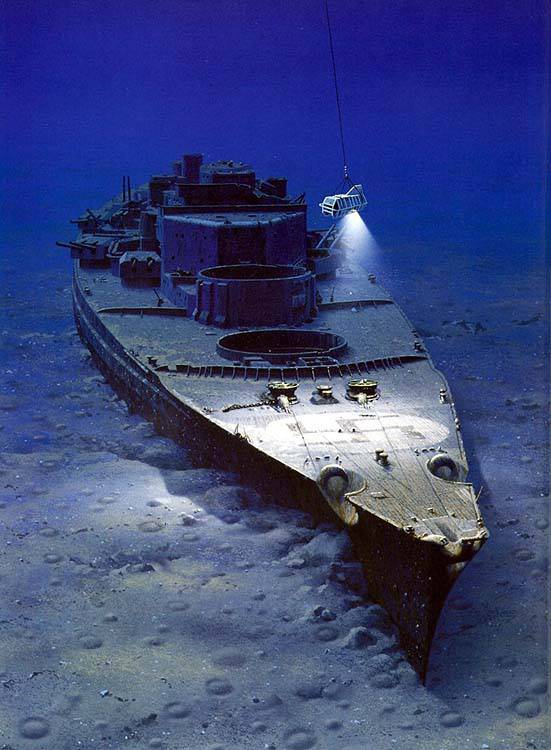
"Dorsetshire" approached the place of death, over which circled the aircraft with the "Ark Royal". Transferring to one of them a request to conduct a search for an underwater enemy, КРТ, swaying violently on the wave, began to take on board the surviving German sailors. After about 80 people were raised, a suspicious smoke was emitted two miles from the windward beam.
The ships of His Majesty "Dorsetshire" and "Maori" managed to pick up 110 people from the water, and only the appearance of the U-74 periscope made them stop rescue ...
ПРИЛОЖЕНИЕ
English shipborne radar on the eve of war
Robots over the creation of radar in the interests of air defense were conducted in the UK since February 1935, when a special research group was formed in Orfordness under the leadership of R. Watson-Watts. In July, a delegation of officers from the Royal Navy School of Communications located in Portsmouth visited the laboratory of this group, and in October joint work began on the creation of ship stations.
Tactical and technical requirements provided for the following conditions to be fulfilled: a warning that an aircraft was approaching at a distance of 60 miles, a precise determination of their position — beyond 10 miles; the ship needed to be detected at a distance of 10 miles, and to accurately determine the coordinates of the target - for 5 miles.
Studies were conducted in different frequency bands of electromagnetic radiation, but the greatest efforts to create an aircraft detection station were focused on the frequency 75 MHz.
At the end of 1936, the first radar model was completed, designated with the cipher Type 79X, which was installed on board the Sultburn (type Hunt) assigned to the School of Communication for testing.
In December, the first series of tests took place, during which the anchored ship found aircraft flying at an altitude of 1500 m at a distance of 17 miles. The next series of tests, postponed until July1937, was carried out using a manually rotating antenna. However, the results turned out to be disappointing - the detection range was fixed not exceeding 8 miles.
In March, 1938 decided to investigate the operating frequency of 43 MHz (which corresponds to the 7,5 m wavelength), the entire program is reviewed and priorities are set: at 1, the 79 radar, which is expected 1500 m) 50 miles; on 2, a radar designed for targeting naval artillery guns to a surface target, which should ensure the accuracy of determining the 1 ° bearing at 20000 yards (18000 m); on the 3-th place - anti-aircraft artillery fire control station, effectively working on the distance 5 miles.
In May, 1938 managed to finish the Type 79Y radar with an operating frequency of 43 MHz, after which the Admiralty ordered the installation of two sets of this equipment on Royal Navy warships. In October, the station was mounted on the Sheffield CRL, and in January 1939 was mounted on the Rodney LC.
The transmitter's peak radiation power reached 15-20 kW, the station was able to detect air targets (CC) flying at 3000 m, at 53 miles, and at 1500 m, the detection range was 30 miles. The station had separate antennas of the emitter and receiver, which were two parallel dipoles with reflectors. The geometrical dimensions of the antennas mounted on the mast posts one below the other were 3,3 on 4,35 m.
Improvement of the radar went the way of increasing the power of the radiation pulse, which on the model "Type 79Z" reached 70 kW. The accuracy of determining the bearing did not exceed 5 °. In September, the Type 1939Z radar 79 was installed on the Crulew anti-aircraft cruiser, the industry received an order to manufacture another 30 kits.
The creation of artillery radar with 1937 was proceeding along the path of using the operating frequency of 1300 MHz, but since March 1937 has switched to 600 MHz. Tests were conducted on EM "Sardonyx" in 1939.
Since the beginning of World War II, the new 1 sea lord W. Churchill, who was shown an artillery radar on the coastal battery, paid great attention to providing ships with such equipment. The first step was the acquisition of the GL1 anti-aircraft fire control radar from the army, which at the end of 1939, under the designation Type 280X, was installed for testing on the anti-aircraft cruiser Carlisle.
The army station was a “supplement” to the optical system and provided only early warning and the issuance of a rough bearing. She worked in the 54-84 MHz band. The fleet improved the station, the tests were carried out in Malta at the beginning of 1940. Although the Admiralty purchased three more sets of such equipment (they were installed on Alynbank, Springbank and Ariguani air defense ships), it was not accepted for service. Royal Navy took the path of "hybridization".
Combining the radio rangefinder “Tour 280” and the detection station of the EC “Tour 79” allowed us to create an artillery fire control station, which was assigned the designation “Tour 279”. Further efforts focused on the development of a universal station; in the fall of 1939, the corresponding TTTs were released.
The enhanced 281 Tour, featuring a detection range increased to 22000 yards (19800 m), was developed by the end of 1940 g. The accuracy of the determination was 25 yards (22,5 m).
Installed in September 1940 on the KLL "Dido" artillery radar "Tour 281" had a working range 86-94 MHz, the pulse power reached 350 kW. The tests showed good results: air targets were detected at a distance of 60-110 miles, surface targets - up to 12 miles. Although the detection efficiency of low-flying targets was higher than that of the “Tour 279” equipment, it was still unsatisfactory.
In January, 1941, the second set of this equipment installed on LC "Prince of Wales". In February, mass production began, 59 kits were released.
In the “Tour 284” station, the power of the emitted pulse was brought to 150 kW, the detection range increased to 30000 yards (27000 m). The range resolution was 164 yards (147,6 m), the angular accuracy was 5 ′. The first set of serial equipment was installed on the “King George V” LC.
This radar turned out to be the most successful, but its range was still smaller than the maximum range of the main caliber of British battleships. Although four of the “capital ships” that took part in the “hunt” on the “Bismarck” had the station “Tour 284”, it did not prove to be anything special.
Artillery radar "Tour of 282" and "Tour of 285", created in 1940-1941, did not differ in reliability and required serious improvement.
In Germany, work on the shipborne radar began in 1933, already in 1937, sea tests of the shipborne artillery Seetakt (FuMo-39), which operated at 375 MHz and had a detection range of 10 miles (pulse power - 7 kW), passed . However, after this work slowed down, and by the beginning of the war only two German warships (including the Admiral Graf Spee) had firing radars of the FuMo-22.
The Freya aerial surveillance radar operated at 125 MHz. The Germans had no ship stations at the beginning of the war.
American specialists developed radar detection of the VC with 1934, V1937, passed sea tests at EM Leary, in December 1938, XAF radar was installed on LC New York. The station operated at a frequency of 200 MHz, the pulse power was 15 kW. The detection range did not exceed that of the English “Tour 79”, but due to the much narrower radiation pattern (around 14 ° instead of 75 °), the angular accuracy reached 3 ° at a higher resolution. Americans from the very beginning used a combined antenna, which was a big step forward.
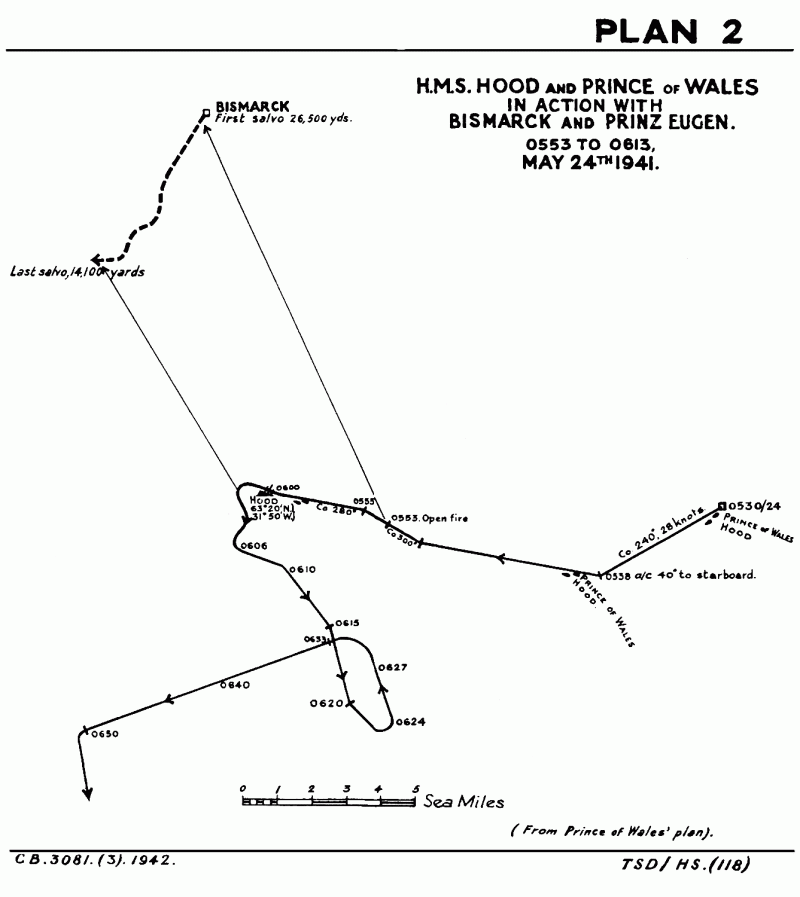
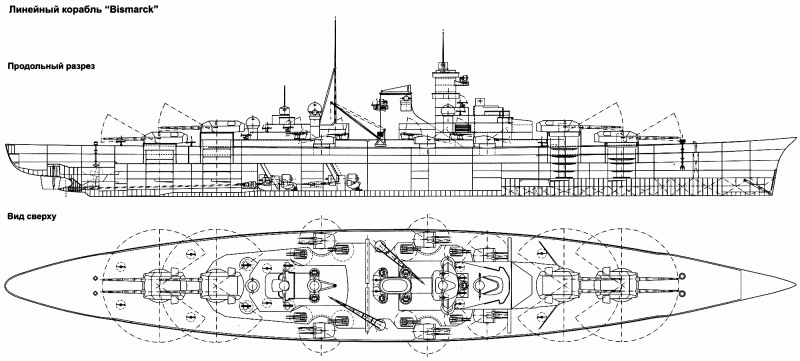
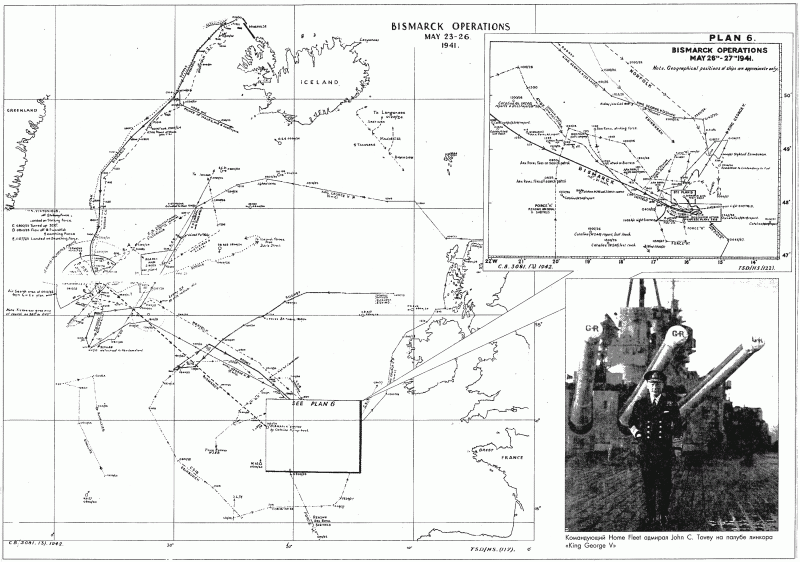
Information